Lexus Enthusiast editor Kevin Watts traveled to San Francisco to test drive the all-new 2018 Lexus LS 500 & LS 500h hybrid. Here is a full technical overview of the new flagship sedan, Kevin’s personal impressions will be posted later this week.
The Lexus LS is the sedan that started a brand.
After five years of development and over $1 billion dollars spent, the LS 400 and the Lexus brand were introduced at the Detroit Motor Show in 1989. With its advanced technology, bullet-proof reliability and value price, the LS transformed the luxury automotive industry for the better.
From that point, the LS has set the tone for Lexus — the second-generation LS arrived in 1994 as an improved carbon copy of the original, the LS 430 in 2000 was the ultimate expression of luxury and reliability, and the 2006 fourth-generation LS 460 helped establish the Lexus L-Finesse design language that reinvented the brand.
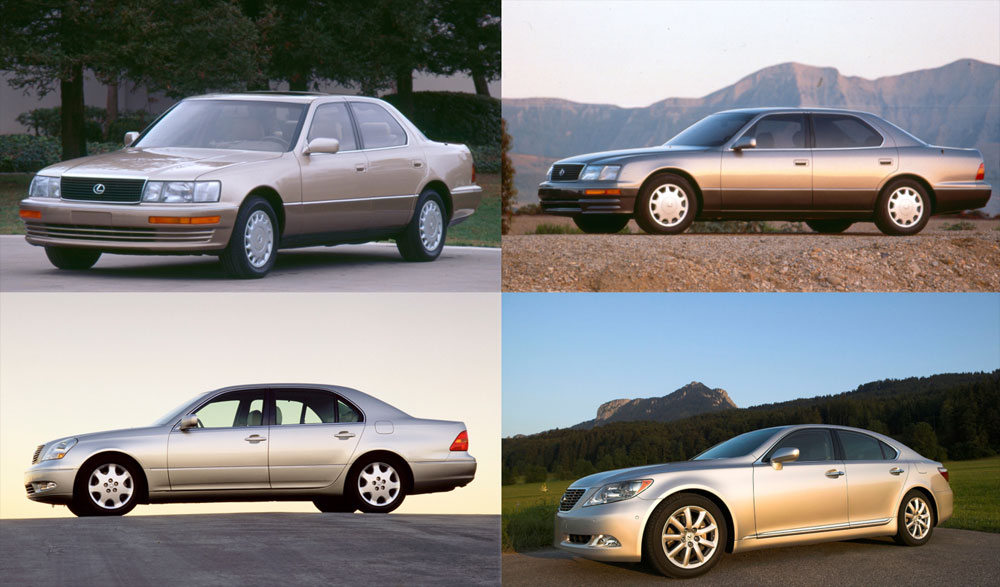
And then, outside of a carryover update in 2012, the character of the LS has gone completely silent.
In a matter of months, the fifth-generation LS flagship will begin arriving at dealerships. Expectations are sky-high, and the danger of disappointment has been compounded by the sedan’s extensive development cycle and its importance in the lineup.
How does this new LS stack up, not just to its competitors, but to the heritage established in 1989? Let’s take a deep dive into all things LS, free of personal opinion. Here are the facts.
Exterior Design
Tasked with developing a concept for the next-generation LS flagship, Chief Designer Koichi Suga created hundreds of tiny sketches on post-it notes:
Eventually, Suga hit on the idea of portraying the four wheels as fireballs, this set up the design theme as “Forged from Passion”:
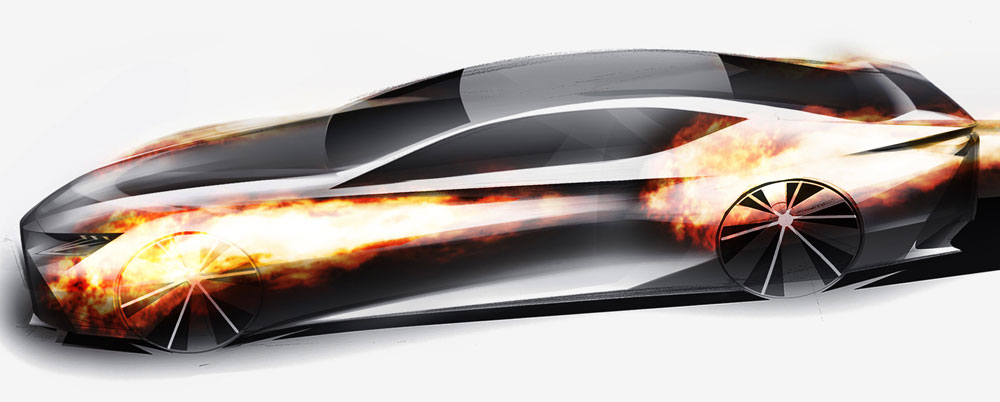
“In the new LS, the sketches were drawn with an emphasis on a flowing silhouette and large tires,” explained Suga. “We wanted to pursue designing flowing pillars, while keeping this idea. To achieve that, the pillars were pushed backwards by adding a piece of glass.”
It was important that the LS silhouette create a sense of unity between the cabin and the body, similar to the LC:
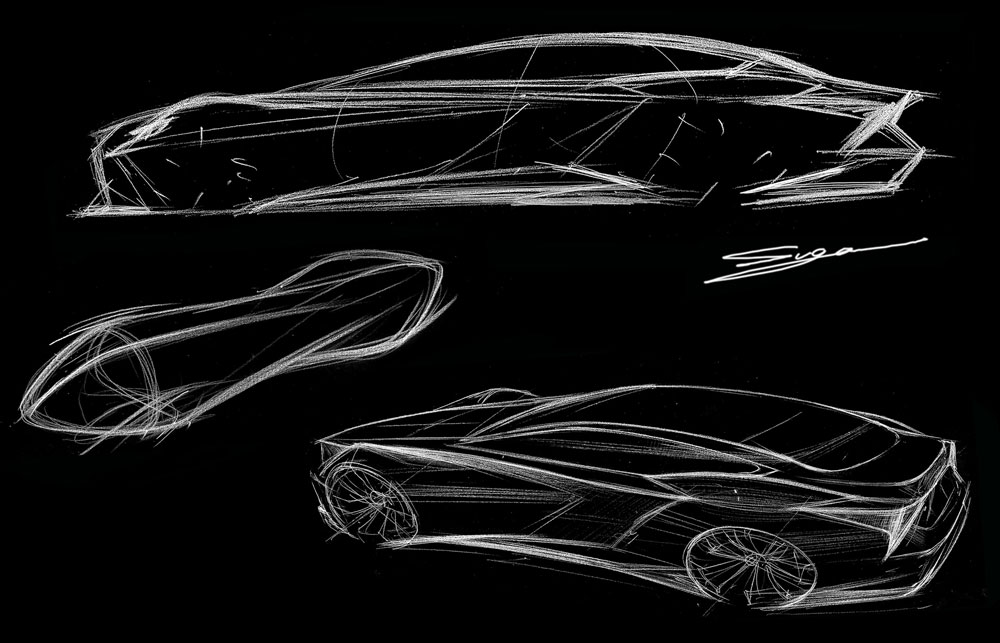
The spindle grille is at the very core of the LS — no longer just ornamentation, but a thread that runs through the entire design:
I would be remiss not to throw in this full 360° video, just as way to see the entire vehicle:
Exterior vehicle lighting builds on the current trend of incorporating the Lexus L pattern — a triple LED headlight has lines like light sabers, and the same theme is repeated in the rear:
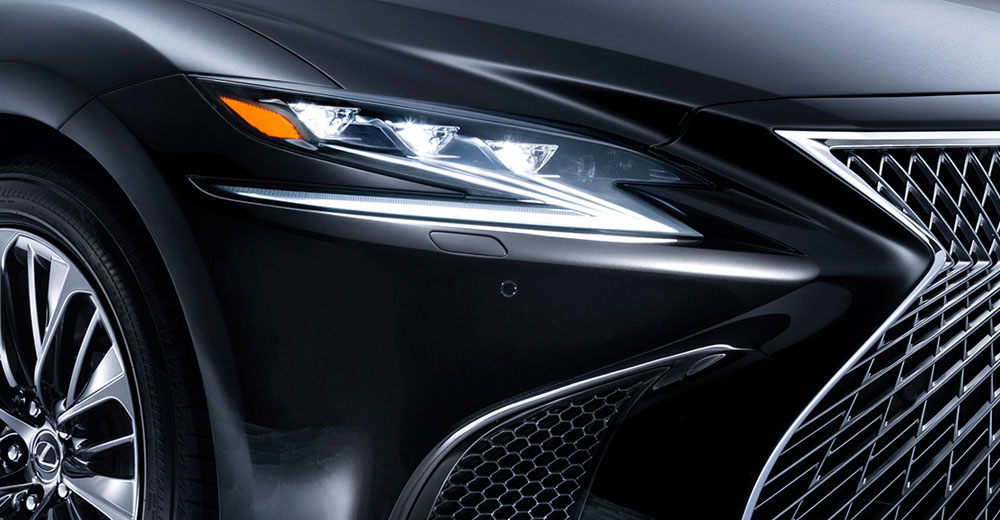
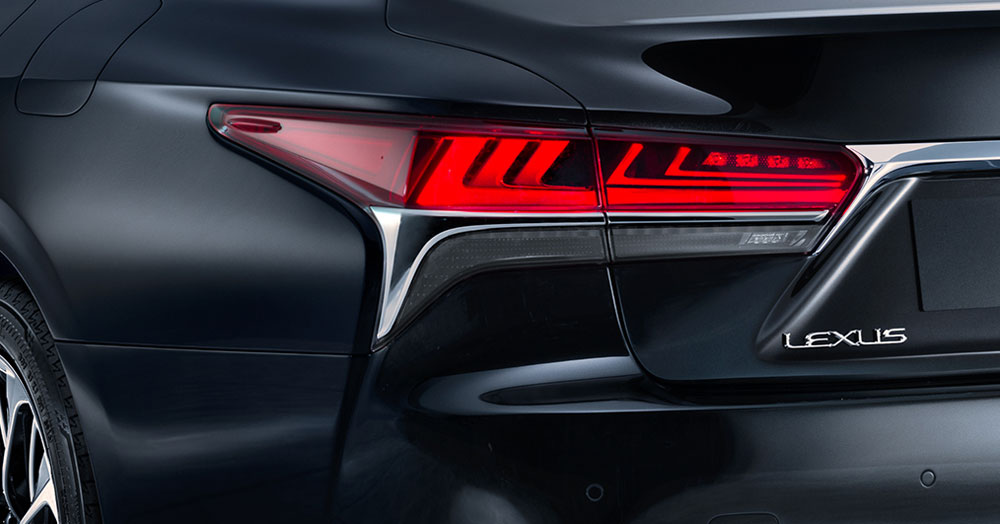
F SPORT
The LS F SPORT package for the new LS has an exclusive front mesh grille design, along with black plating applied to grille frame, rocker molding accents and trunk lip:
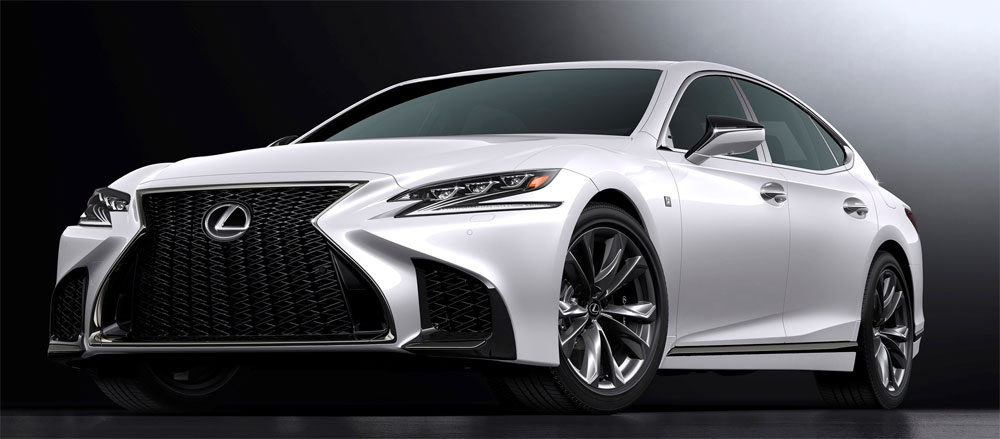
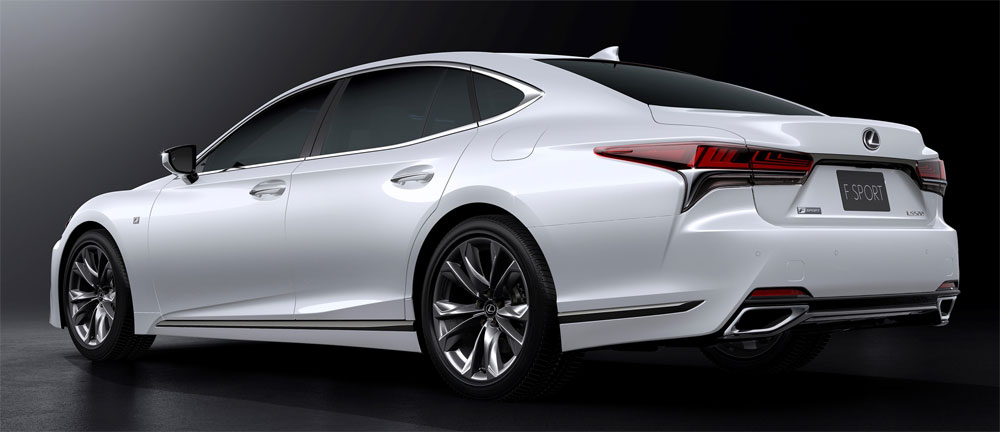
Panoramic Glass Roof
A panoramic glass roof will be available, with a front glass panel that extends out and slides to the rear:
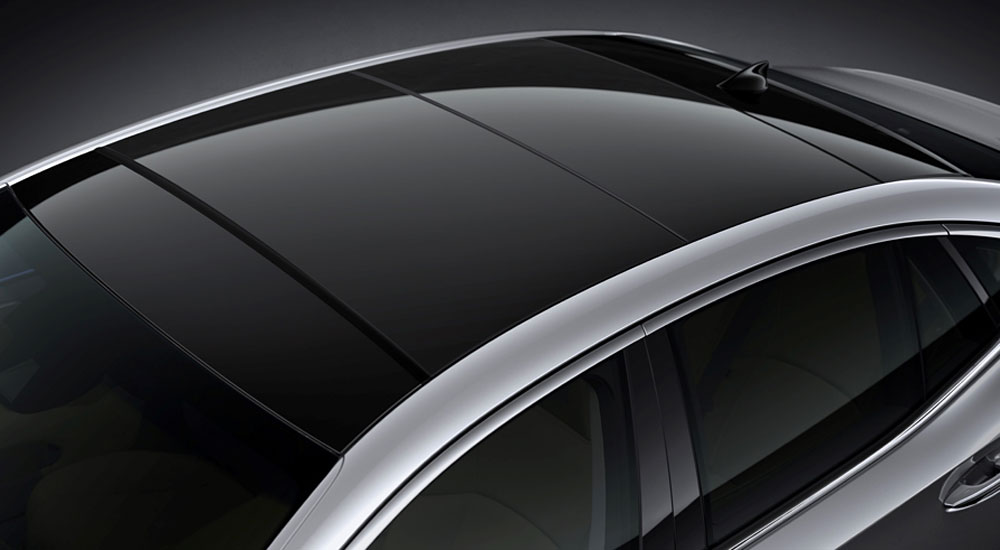
The front and rear parts of the roof are painted black to match the glass, and the rear glass panel is a couple inches wider for a more expansive rear seat view.
Wheels
The LS will be available with five wheels — four newly developed designs and one 20-inch forged wheel design that is shared with the LC:
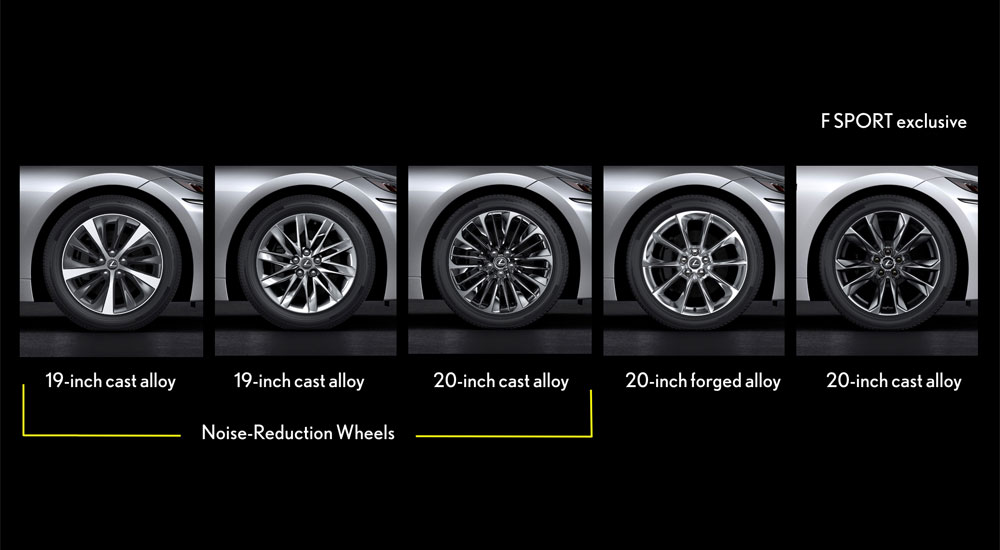
Three of the wheels are designed to suppress road noise — this is accomplished using a hollow section in the rim that resonates with the air in the tires, causing friction and converting sound waves to heat.
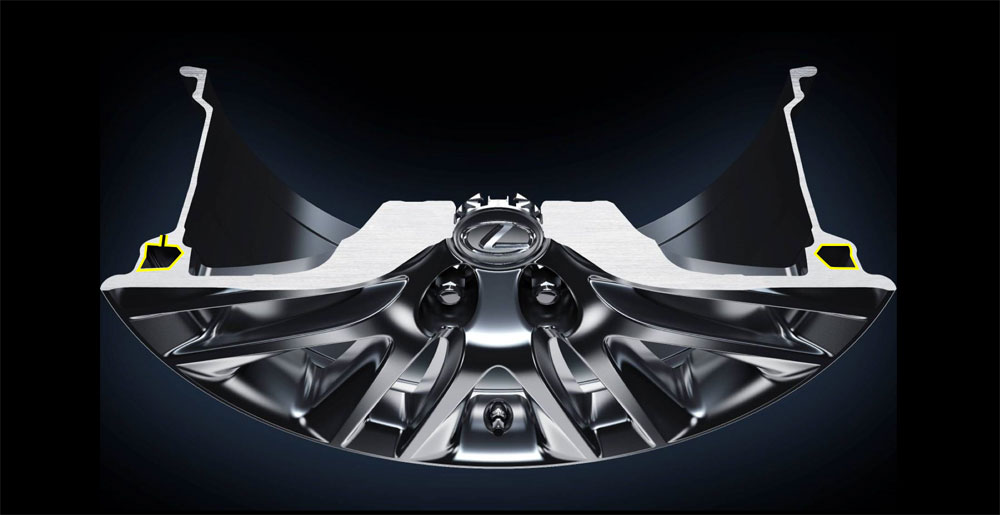
Power Trunk
There’s also an available hands-free power trunk feature that activates when it detects a foot under the rear bumper:
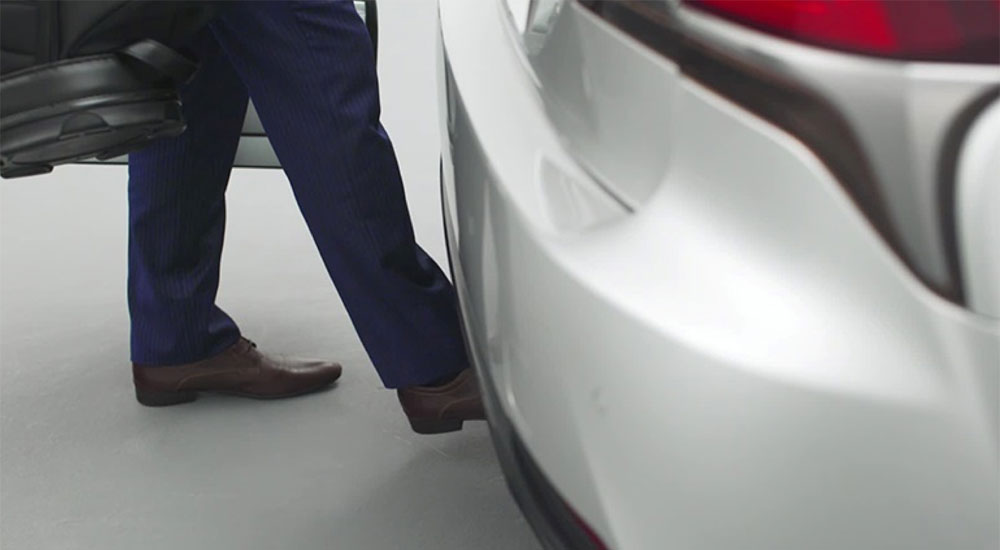
Interior
The inside of the Lexus LS is infused with concept of Omotenashi, or the Japanese way of hospitality, of going beyond what is necessary to please a customer or guest.
The interior design revolves around the seats, which were made to mimic the comfort of a plush armchair with its substantial armrests:
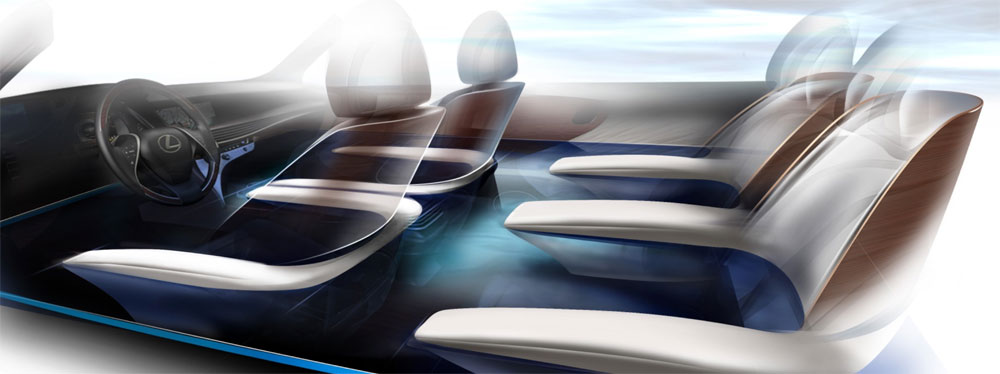
The sweeping lines of the dashboard was inspired by chasen bamboo whisk used in Japanese tea ceremonies:
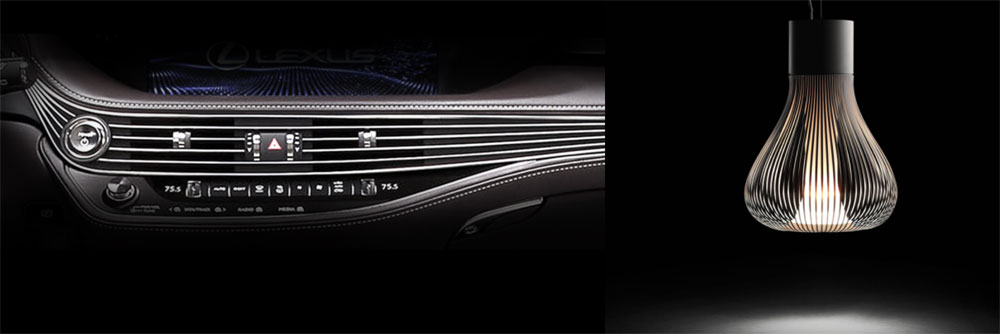
The LS Interior lighting was also derived from Japanese tradition, this time using the soft Andon lights to create a warm, comforting environment:
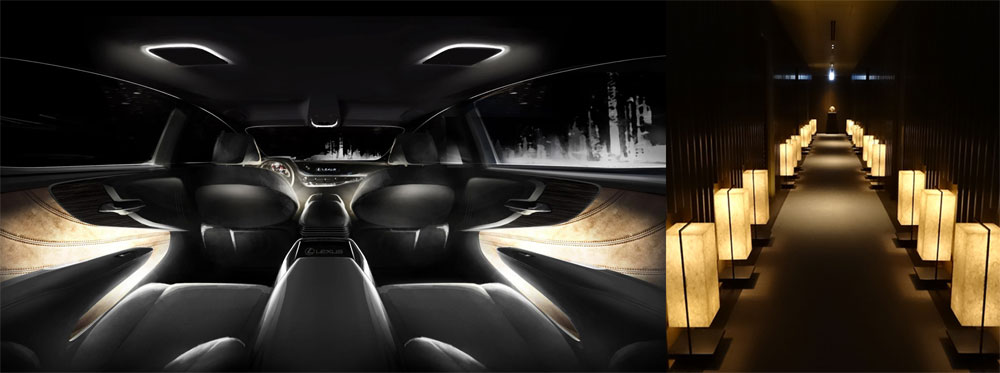
Japanese Takumi craftsmanship played a strong role in the material design inside the new LS — here’s a video showing the creation of the pleated fabric door panels and Kiriko Glass trim:
Seating
Great improvements have been made to the seating in the new LS, and it all starts with the available 28-way adjustable front seats:
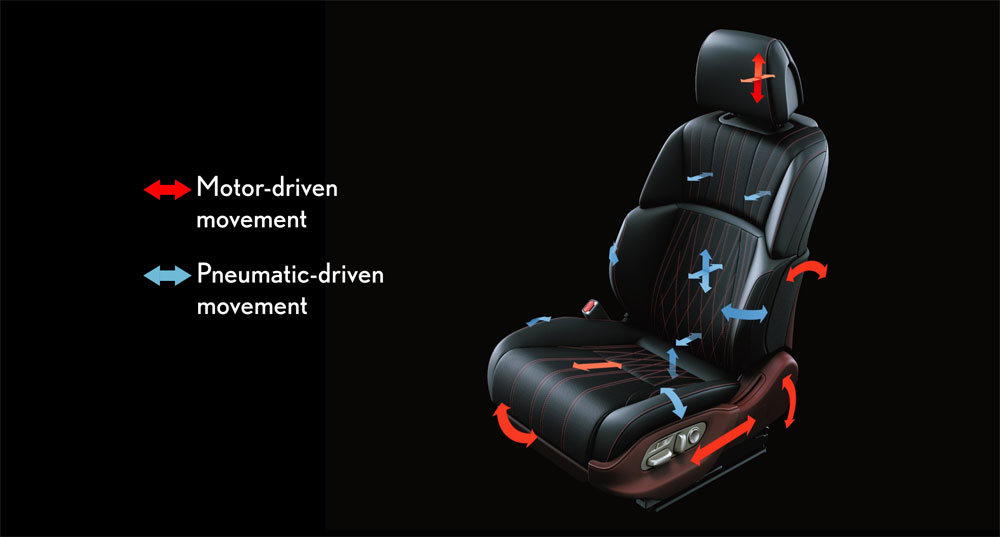
As seen in the illustration, electric motors have been combined with a pneumatic system for control of the entire seat. Basic adjustments are made using the usual side switches, but the seat can be fine-tuned using the multimedia display.
- Side of seat: Sliding, reclining, lifter and tilting, variable cushion length, lumbar support front and back movement, lumbar support up and down movement
- Display: Lumbar support front and back movement, lumbar support up and down movement, headrest up and down movement, headrest front and back movement, back pelvis support, hip support, shoulder support, back side support, cushion side support, front refresh function
The front seats also allow for easy entry & exit, with an automatic raising and lowering of the seat. The outside thigh bolster will even compress so as not to get in the way.
Beyond this excess customization, Lexus has taken the front seats one step further by adding an available massaging option:
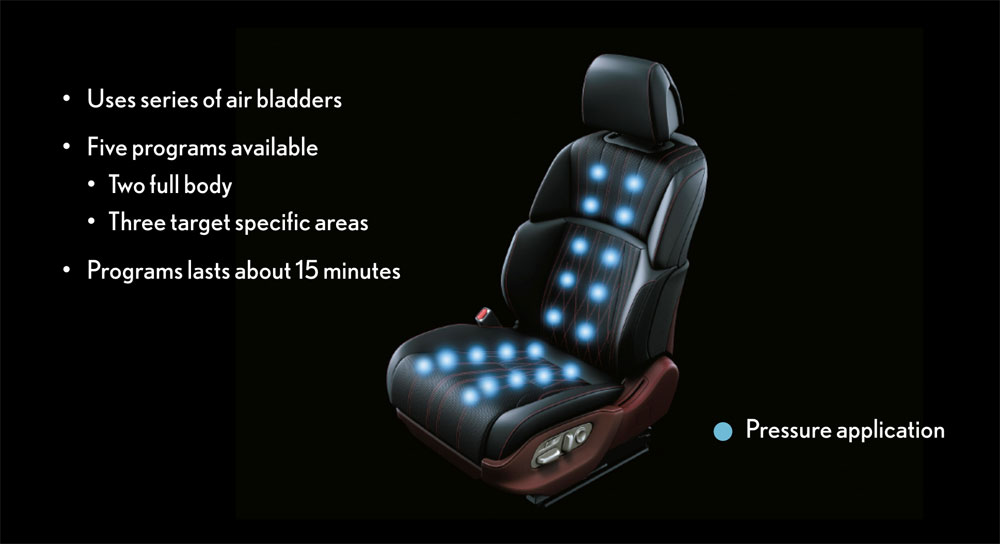
The system uses a series of air bladders to apply pressure from the thighs to the shoulders — there are two full-body massages and three options that target specific areas, with each program scaling five intensity levels and lasting about 15 minutes.
Like the previous LS, there’s plenty of luxury in the rear seats as well:
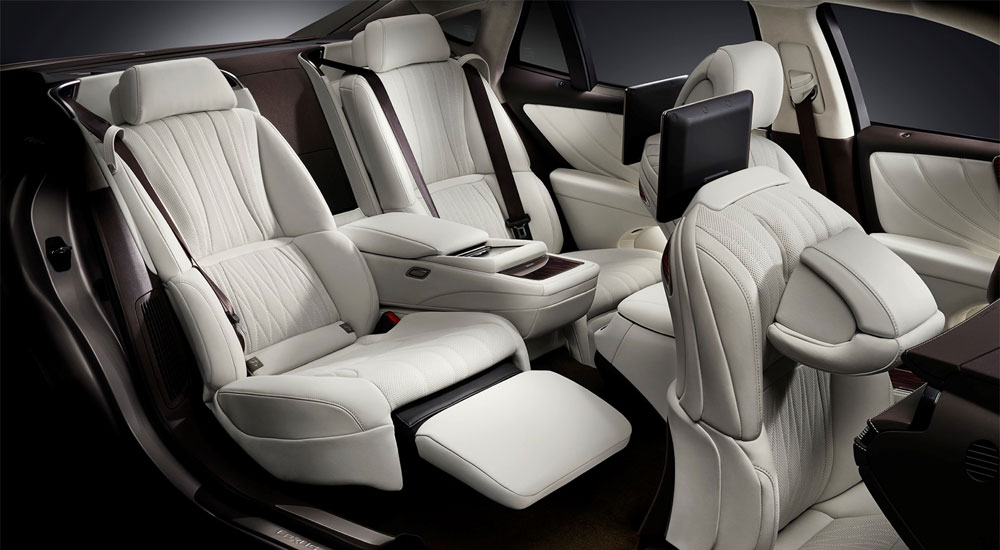
The passenger-side ottoman seat provides additional recline and a power leg rest, with 22-way adjustment using the same electric motor/pneumatic system as the front:
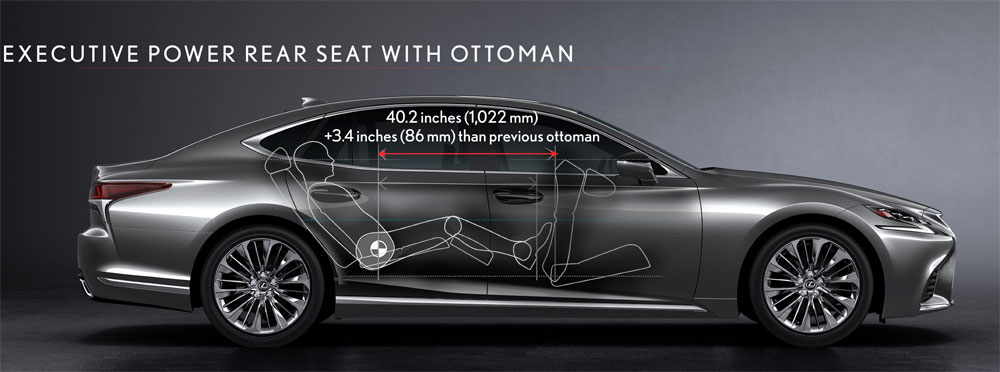
Controls are embedded in the central armrest touchpad, along with settings for audio, climate, sunshade, and lamps:
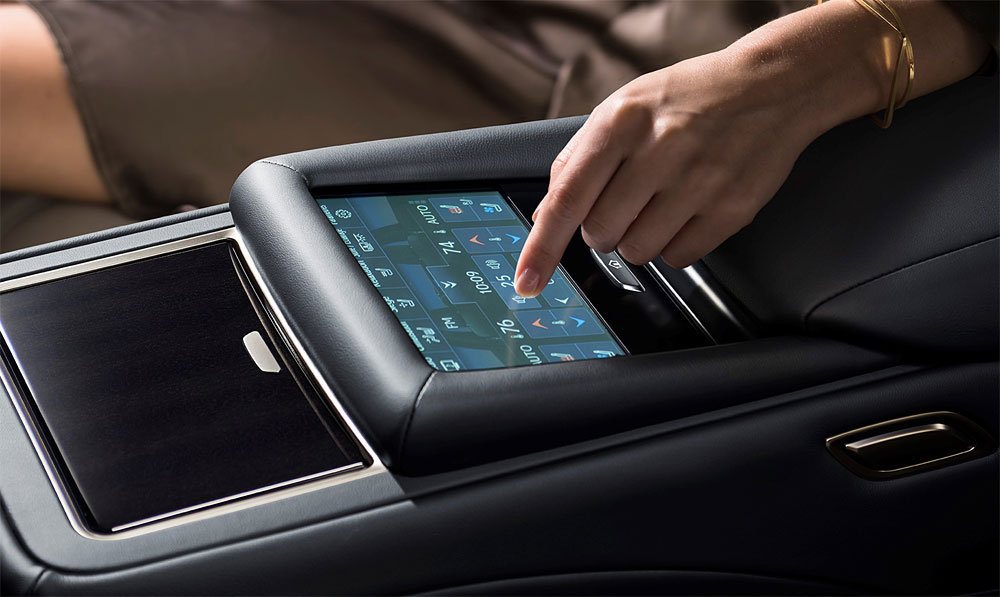
Lexus LS 500 Engine & Transmission
The fifth-generation Lexus LS will debut the V35A-FTS twin-turbocharged 3.5-liter V6 developed specifically for the new flagship.
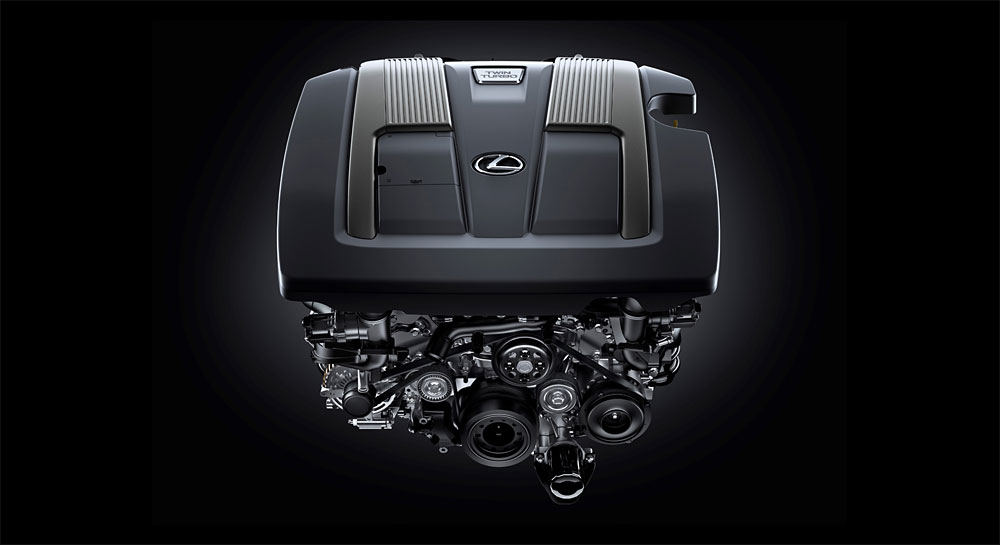
The new engine puts out 416 horsepower and 442 lb-ft of torque, and represents a major upgrade over the outgoing 4.6L V8 of the current model. In terms of raw information, here’s the point form:
- DOHC 24-valve twin turbocharged V6 with intake VVT-iE and exhaust VVT-i continuously Variable Valve Timing with intelligence and D-4S direct-to-cylinder injection system plus secondary port injectors
- Displacement: 3444 cm (210.2 cubic inches)
- Bore x stroke: 88.5mm x 100mm (3.37 inches x 3.94 inches)
- 416 horsepower @ 6000 rpm (310 kW, 421 ps)
- 442 lb.-ft. of torque @ 1600-4800 rpm (600 Nm, 61.2 kg-m)
- Flat torque curve from 1,600 RPM to 4,800 RPM
There’s even a diagram:
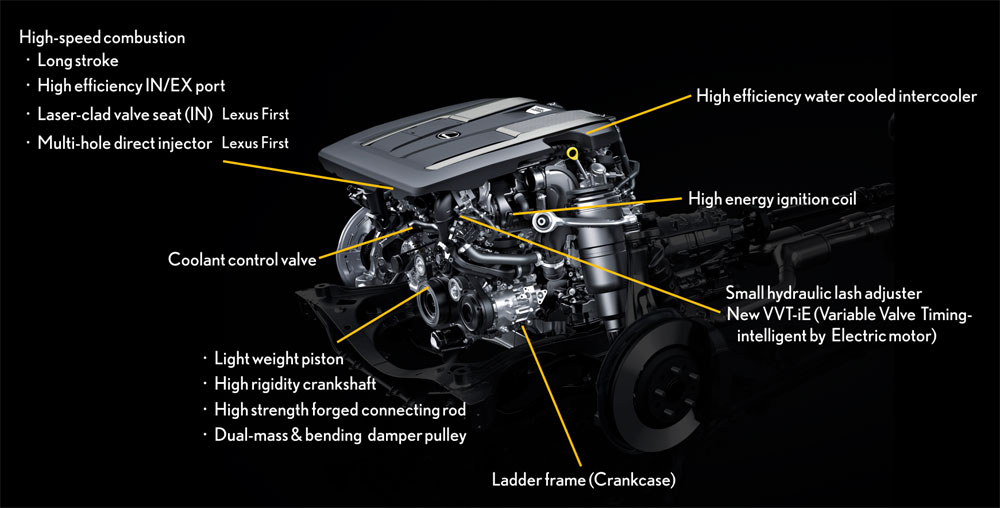
In building the V35A-FTS, engineers turned to Toyota’s shuttered F1 program and ongoing race efforts in World Rally Championship and World Endurance-Racing Championship. The result was a major redesign of the intake ports, including an increased valve angle and the use of laser-clad intake valve seats in the cylinder heads — here’s a video demonstration comparing old and new:
The LS 500 marks the first time twin turbochargers have been used in a Lexus vehicle. Rather than outsourcing the tech, the system was designed and produced in-house to ensure LS flagship levels of performance and quiet operation.
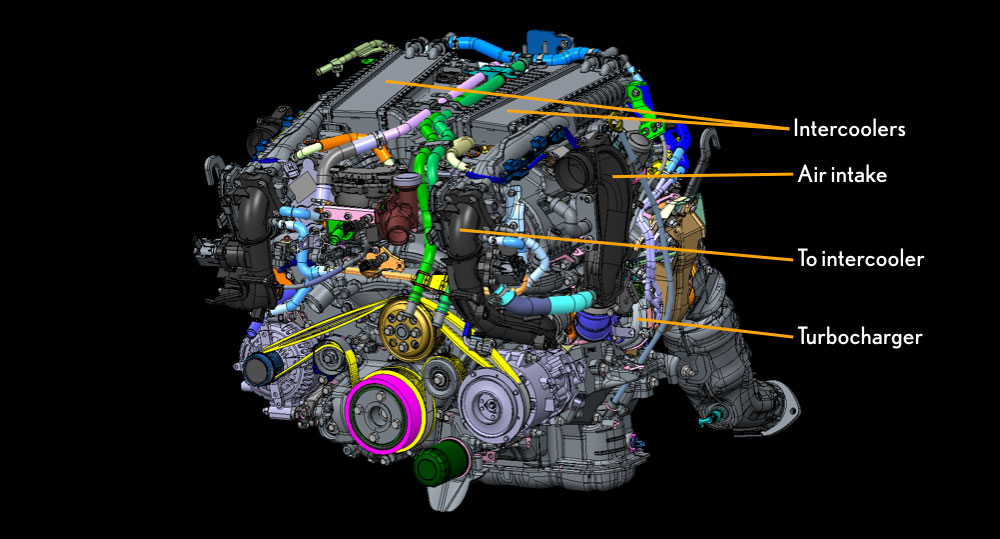
Compared to a conventional turbocharger, the V35A-FTS uses a longer turbine with curved blades, ensuring consistent turbo boost and availability even at low engine speeds. The system is controlled by a proprietary electric-actuator wastegate — an electric wastegate valve is used to control turbocharger boost, output, fuel economy, and emission performance, while a motorized actuator is used to control the opening and closing of the valve.
A new version of the Lexus D-4S gasoline direct injection plus port injection system was developed for the TTV6 — called D-4ST, it controls new six hole direct injectors and the port fuel injectors. To reduce lag, twin water-to-air intercoolers are mounted on top of the engine, directly between the turbochargers and intake throttle.
Remarkable powertrain smoothness, a Lexus hallmark, begins deep inside the cylinder block, where a ladder frame support for the crankshaft main bearings adds rigidity for low vibration. Redesigned engine mounts, the electric wastegates and numerous other features also contribute to the engine’s ultra-smooth demeanor.
As for fuel economy — the rear-wheel drive LS will get City 19 mpg/ Highway 29 mpg/ Combined 23 mpg, while the all-wheel drive model will rate at City 18 mpg/ Highway 27 mpg/ Combined 21 mpg.
LS 500 Transmission
The LS 500 uses the same 10-speed direct-shift automatic transmission that debuted in LC coupe:
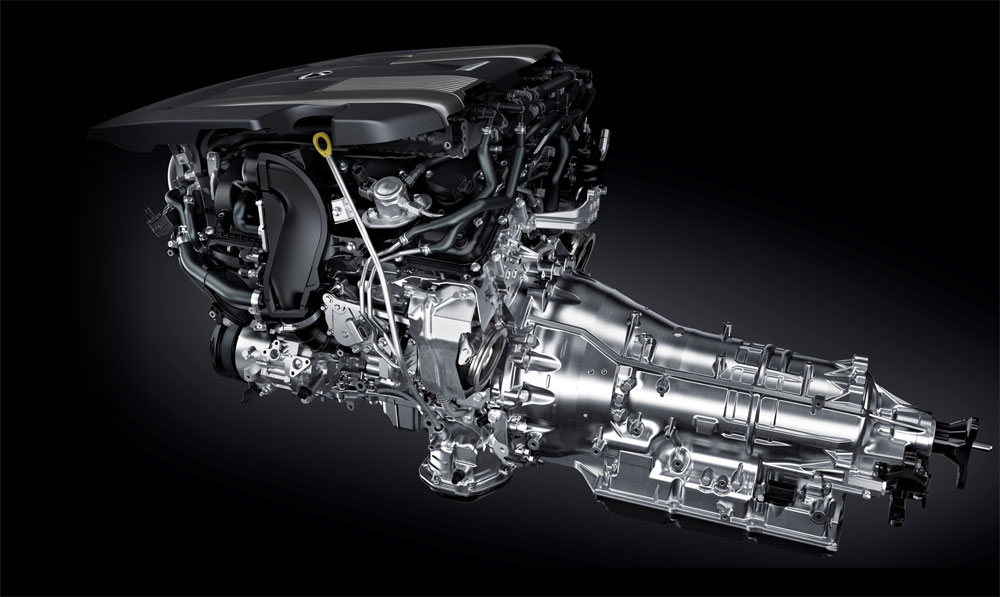
Despite having two more gears, the new transmission weighs the same as the outgoing 8-speed gearbox — this was done by using aluminum for the clutch drum, clutch hub and planetary carrier, along with a resin plastic oil pan.
The engine and transmission are directly connected via torque converter lockup control, which is only disabled during acceleration from a stop.
Built into the transmission is AI-Shift Control, an artificial intelligence module that will hold or shift a gear depending on the driver’s prior history, current acceleration, braking and lateral-g forces. There are also steering wheel shifter paddles on every LS model.
Lexus LS 500h Powertrain
The LS 500h shares the same Multi-Stage Hybrid system from LC 500h, and its goal is to bring a new level of performance to hybrid technology:
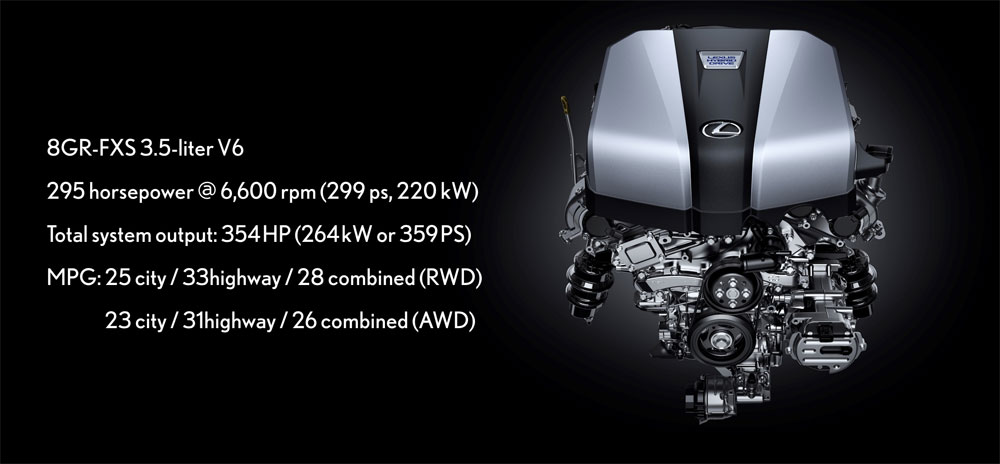
At the heart is the 8GR-FXS 3.5-liter, 24-valve, naturally aspirated V6 with dual intelligent variable valve timing, with 295 horsepower and 257 lb.ft of torque. The LS 500h also has an electric motor to boost power and improve efficiency, using a lithium-ion batteries rather than nickel–metal hydride:
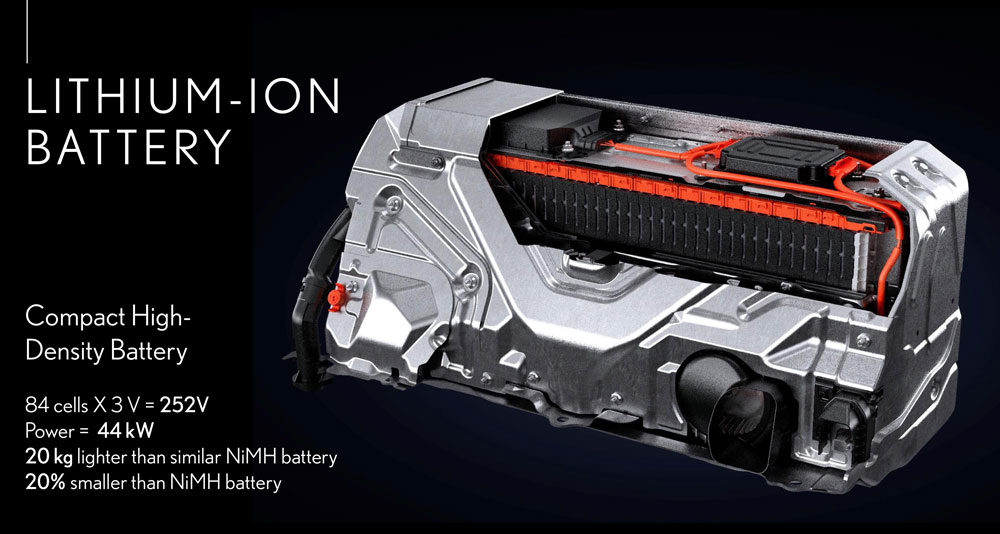
This new battery pack is 20% smaller and 44 pounds lighter than the unit used in the LS 600h, meaning less weight and more efficient use of space. It fits between the rear seats and the trunk, and has 84 battery cells producing 310.8 volts.
From here, things get trickier to explain — here’s a video from Lexus that explains how the transmission works in the Multi Stage Hybrid System:
If for any reason you’re unable to watch the video, here’s a convoluted explanation — the power coming from the V6 and the electric motor are amplified through a four-speed automatic transmission embedded inside a continuous variable transmission. This “dual” transmission provides stepped access to the torque generated by the electric motor, and recreates a 10-speed transmission with three virtual gears between each of the automatic transmission’s physical gears.
Suspension & Chassis
The new LS shares the GA-L chassis with the LC coupe, taking advantage of the lower profile and long-wheelbase to optimize the driving position, vehicle dimensions and vehicle mass:
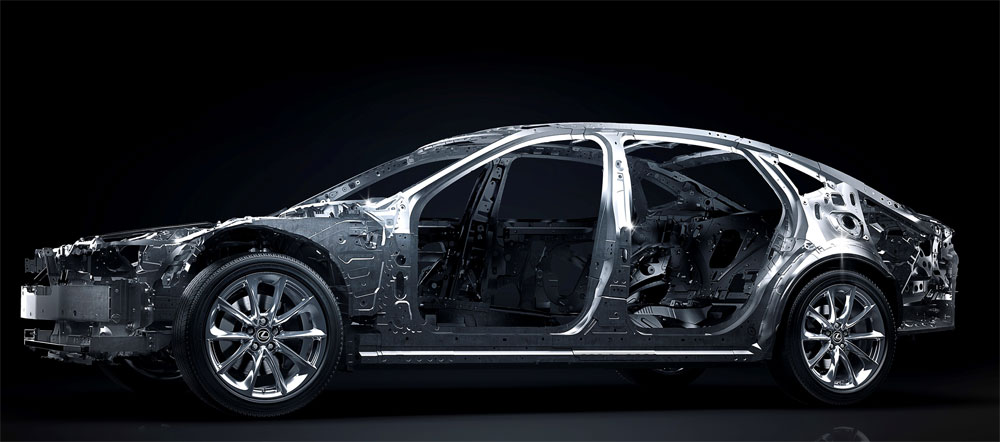
When compared to the current LS, the new model is 15mm (0.6 inches) lower overall, with the hood about 30mm (1.2 inches) lower and the trunk 40mm (1.6 inches) lower.
The front tires were moved forward, while the driving position and twin-turbo V6 engine moved rearward. With the LS 500h, the hybrid battery was moved forward:
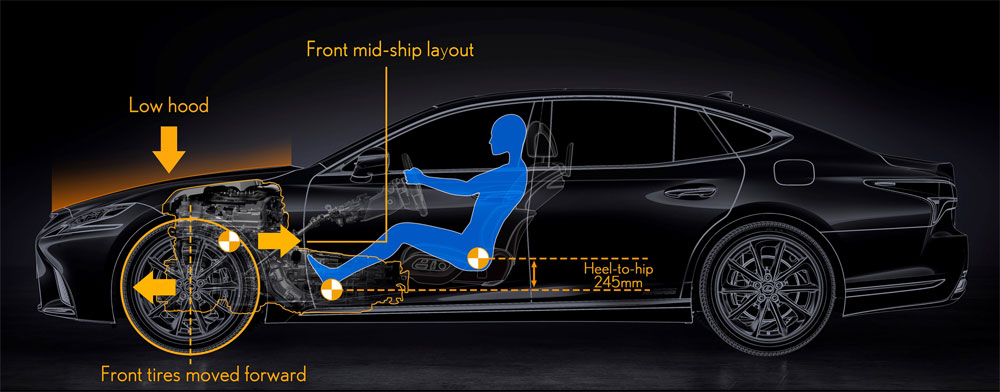
Overall weight distribution is 53/47 front/rear for the LS 500 and 51/49 for the LS 500h, while the center of gravity sits at 540mm — only 30mm, or 1.2-inches, higher than the LC coupe.
Let’s break down all the various weights of both the LS 500 & LS 500h:
| Model | Weight |
| LS 500 RWD with Air Suspension | 4,751lb (2,155kg) |
| LS 500 RWD with Coils & AVS | 4,707lb (2,135kg) |
| LS 500 AWD with Air Suspension | 4,938lb (2,240kg) |
| LS 500 AWD with Coils & AVS | 4,905lb (2,225kg) |
| LS 500 RWD with Executive Package | 4,905lb (2,225kg) |
| LS 500 AWD with Executive Package | 5,093lb (2,310kg) |
| LS 500h RWD with Air Suspension | 4,883lb (2,215kg) |
| LS 500h RWD with Coils & AVS | 4,850lb (2,200kg) |
| LS 500h AWD with Air Suspension | 5,071lb (2,300kg) |
| LS 500h AWD with Coils & AVS | 5,027lb (2,280kg) |
| LS 500h RWD with Executive Package | 5,027lb (2,280kg) |
| LS 500h AWD with Executive Package | 5,225lb (2,370kg) |
Materials
Stamped aluminum was used for the hood, front fenders, doors and trunk lid:
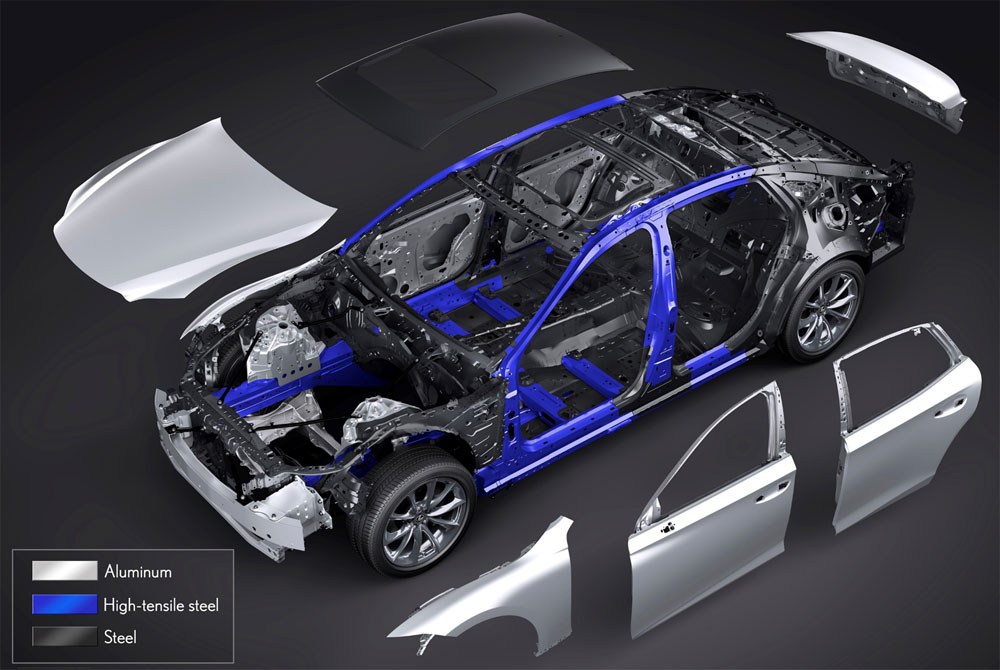
Both the front and rear suspension towers are die-cast aluminum, which is approximately double the rigidity with 42% less weight at the front, and approximately 1.5 times the rigidity with 50% less weight at the rear:
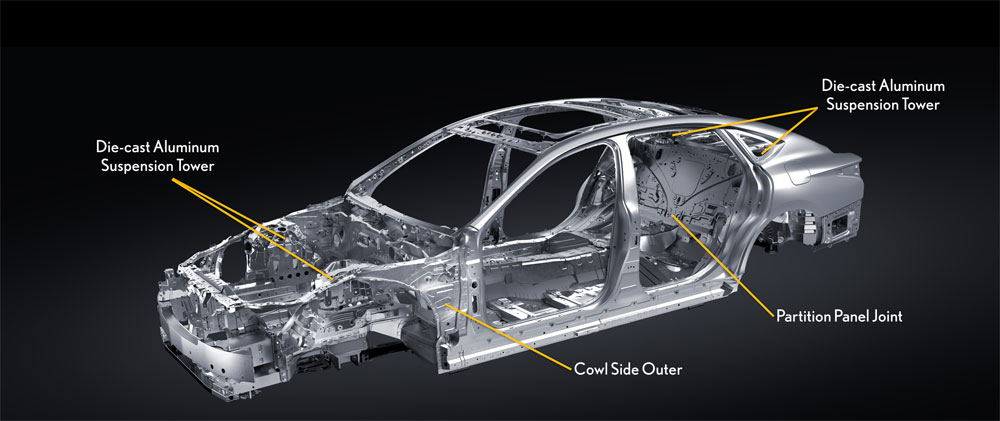
Other chassis improvements were made, including the removal of the service holes connecting the front pillar & apron member, and joining the partition panel behind the rear seats with the rear floor cross member. i
To connect the aluminum and steel, Lexus engineers used adhesive and rivets for the joints, then applied sealant to the joints to prevent any rusting. Overall use of structural adhesive has been significantly increased — on the underbody alone, there is 32.8 meters of glue used, versus just 5 meters in current LS.
Aerodynamics
Aerodynamics is always a big part of how the overall design of a vehicle flows — here’s the profile for the new LS:
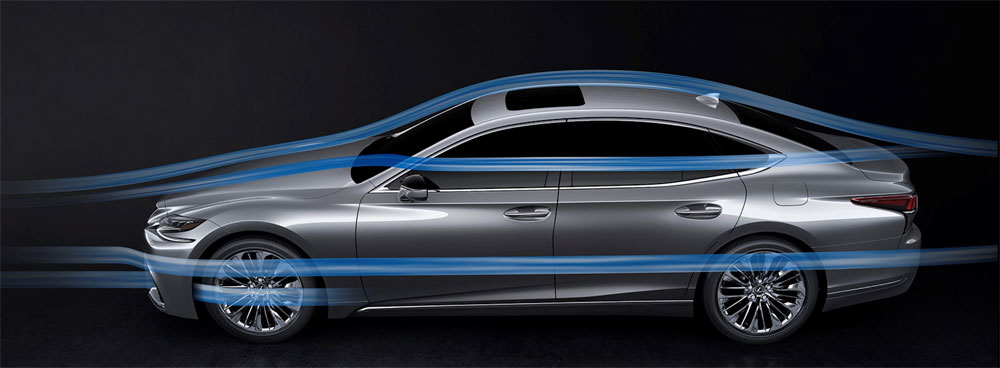
The front bumper has been shaped to allow air to pass along the sides of the vehicle, while the aero stabilizing fins in the door frame molding and rear combination lamps improve stability by directing the current.
The LS has flush side window glass, which reduces the turbulence that happens when air flows over uneven surfaces. The flagships is almost fully covered underneath — there are also vertical fins behind the rear tires to control the air and reduce drag:
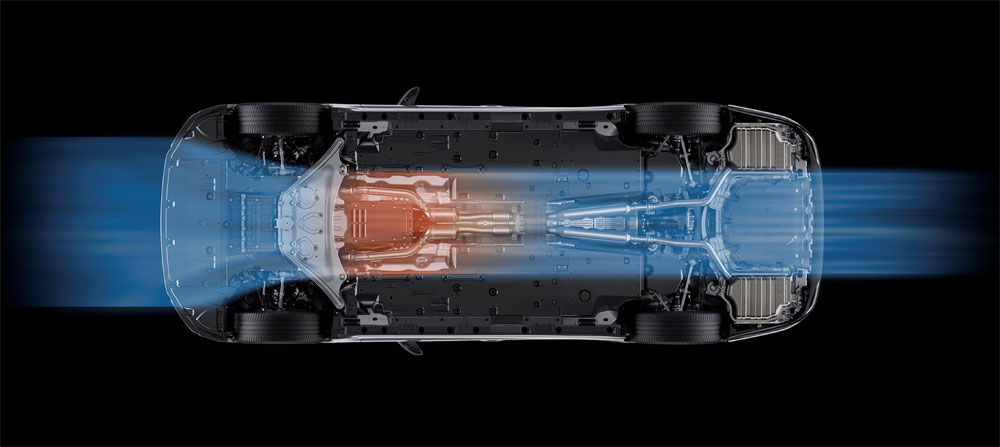
Coil Suspension
A new multilink front suspension is standard on the LS, with double ball joints on the upper and lower control arms:
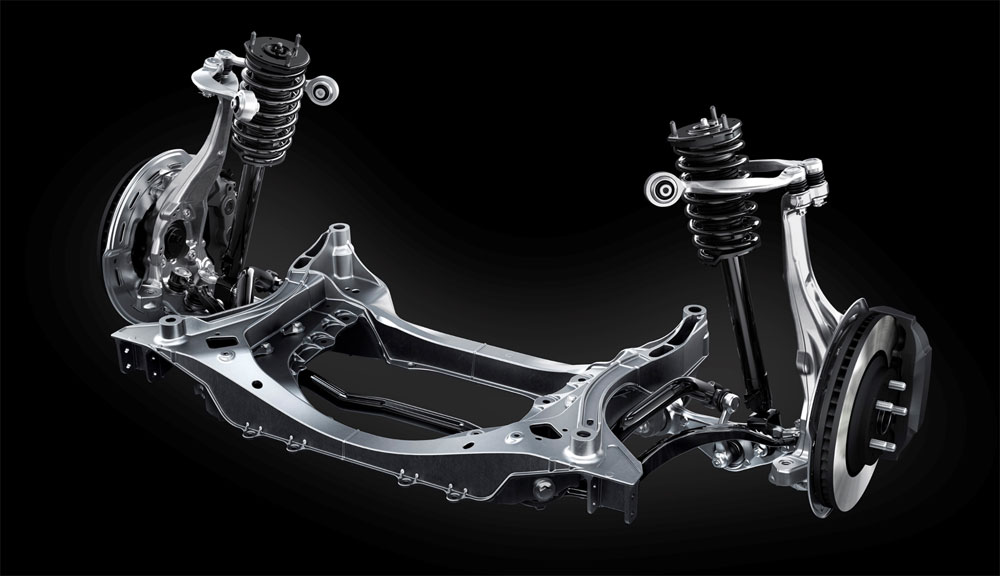
With all-wheel-drive models, the lower arm locations have been adjusted in the front suspension to enhance straight-line stability and comfort.
The LC coupe multilink rear suspension has been adopted by the LS, though with adjustments to the bushings for a more compliant ride:
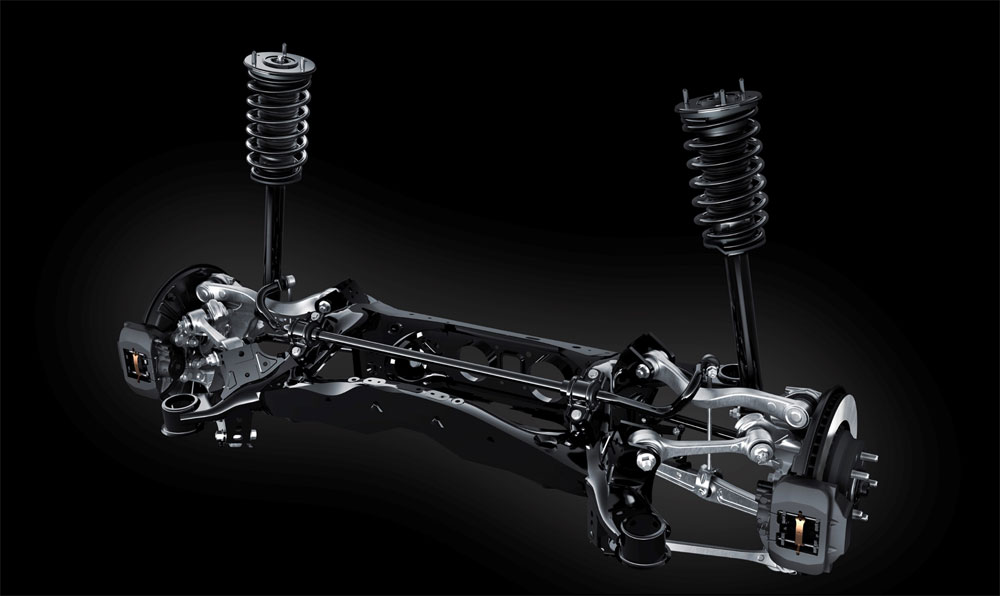
Adaptive Variable Suspension
Lexus Adaptive Variable Suspension (AVS) uses G force, yaw-rate and speed sensors to configure the suspension depending on road conditions and driving input.
AVS controls the shock absorber damping force on all four wheels, and with the LS, the system has had a major upgrade — the linear solenoid actuators are now capable of 650 distinct levels, up from 9 levels on the previous step motor.
Air Suspension
Air suspension is an available feature with the new LS, and it uses a closed system with compressed air stored in a pneumatic tank for faster height adjustment:
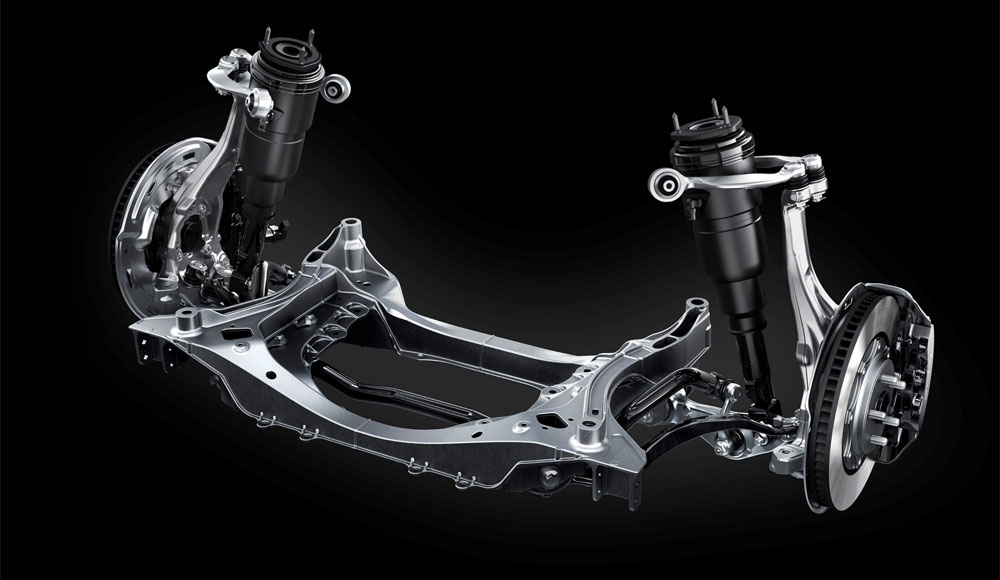
This makes a new Access Mode possible, as the LS will automatically raise and lower to different heights depending on if occupants are entering or leaving the vehicle.
Brakes
The LS comes standard with opposed 4-piston front and 2-piston rear calipers, all made from a single piece of aluminum monoblock with spiral-ventilation. Measured out, the front are 357mm x 34mm (14.0 x 1.3-inch) and the rear are 335mm x 25mm (13.1 x .9-inches):
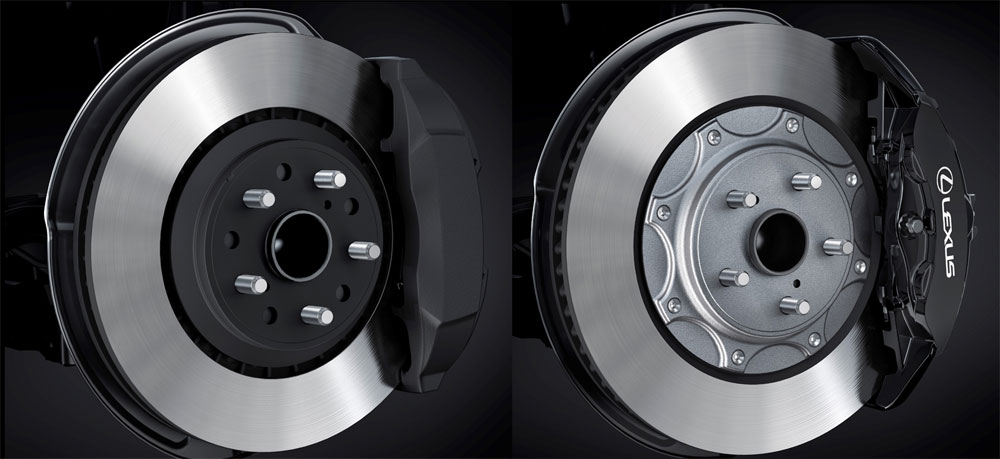
The F SPORT package includes upgraded brakes, with opposed 6-piston front and 4-piston rear calipers also made from 1-piece aluminum monoblock with spiral-ventilation. Measurements are 400mm x 36mm (15.7 x 1.4-inch) in the front and 359mm x 30mm (14.1 x 1.2-ich) in the rear.
Run-Flat Tires
Run-flat tires are now standard, with reinforced rubber on the sidewalls that allow up to 100 miles (160 km) at 50 mph (80km/h) with a flat:
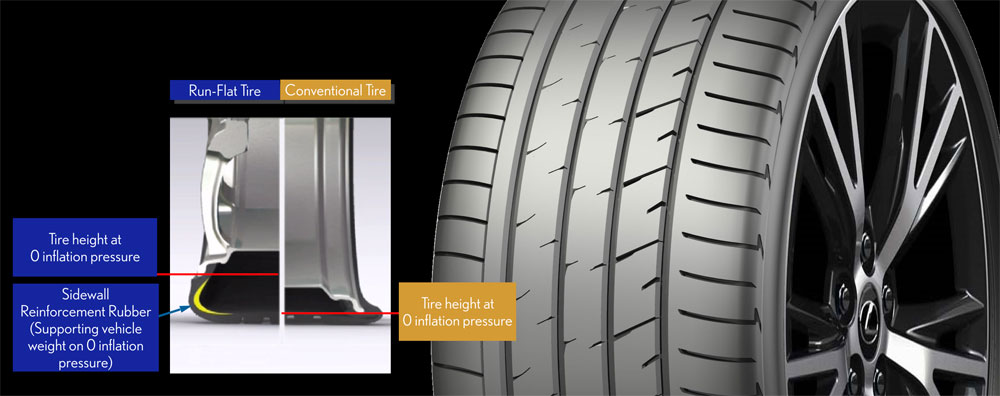
Lexus LS models equipped with 19-inch wheels will have 245/50RF19 all season tires, while 20-inch wheels are 245/45RF20 all seasons. The F SPORT package comes standard with staggered 20-inch wheels — 245/45RF20 in the front and 275/40RF20 in the rear.
Tire brands will be a mix of Bridgestone, Dunlop, and Michelins.
F SPORT Performance Package
The LS 500 RWD F SPORT will be available with Vehicle Dynamics Integrated Management (VDIM) Step 6, which boosts a world-first six types of vehicle movement — longitudinal, vertical, lateral, yaw, roll and pitch — based on acceleration, steering and braking inputs:
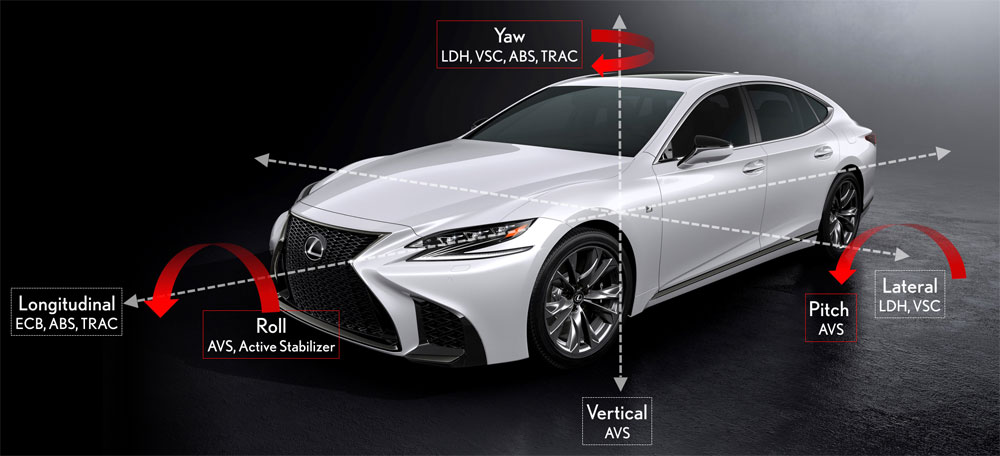
VDIM Step 6 integrates all driving systems into a single response — most will be familiar, such as the Anti-lock Braking System (ABS), Traction Control (TRAC/TRC). Vehicle Stability Control (VSC), and Electronic Power Steering (EPS). The final three systems deserve some explanation.
Variable Gear-Ratio Steering (VGRS)
Variable Gear-Ratio Steering (VGRS) adjusts the steering angle depending on vehicle speed and driver steering input — this enhances steering when turning and during lane changes, while boosting input at low speeds for quick maneuverability.
Lexus Dynamic Rear Steering (DRS)
Lexus Dynamic Rear Steering (DRS) debuted with the fourth-generation GS sedan in 2012, and this video from that launch is still the best explanation of the system:
Lexus Active Stabilizer System (LASS)
The final piece of the VDIM Step 6 system is an active stabilizer suspension, for suppressing vehicle roll without an adverse effect on ride comfort:
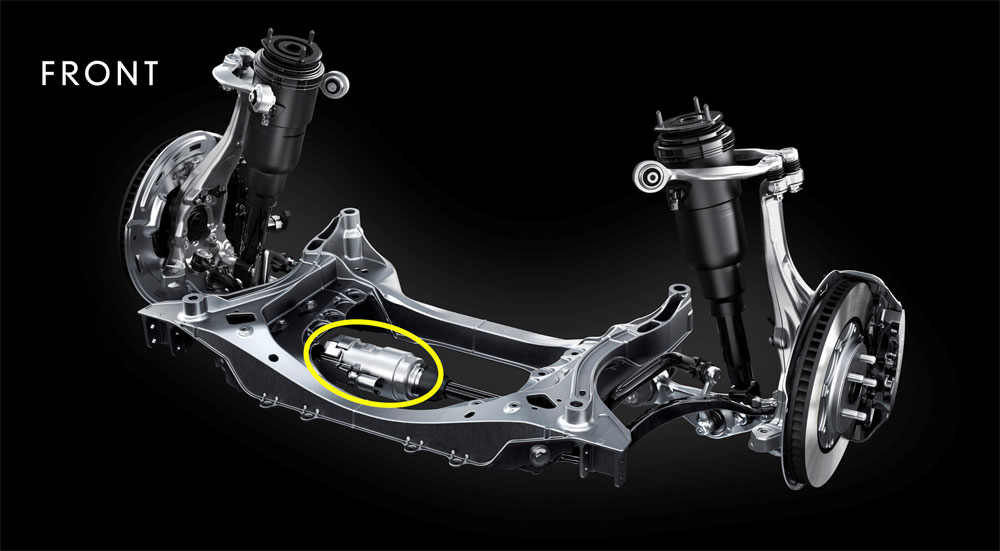
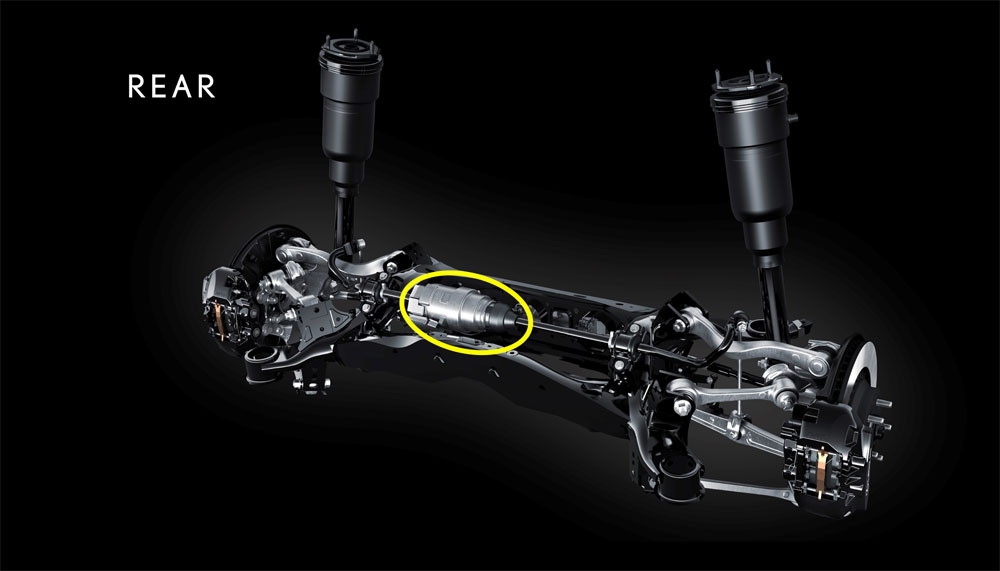
These three systems work together to enhance driving performance — a slide from the Lexus presentation explains it best:
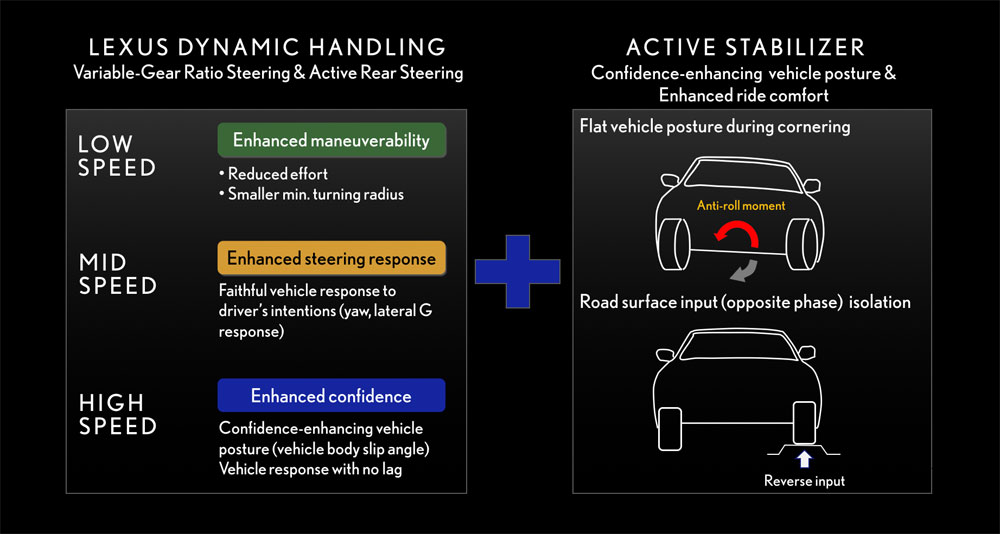
It takes seven separate technologies to form VDIM Step 6 — here’s a flowchart that shows how driver input is translated through the Engine Control Unit (ECU):
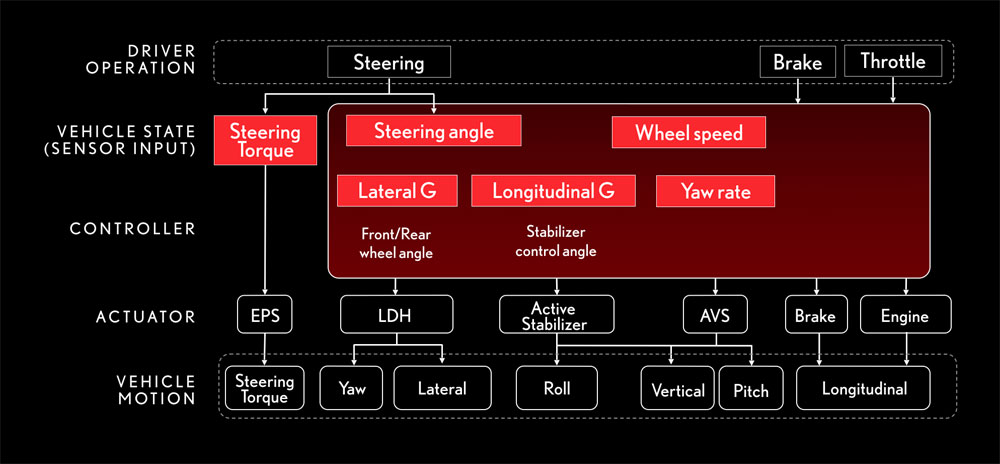
Interior Technology
The driving experience starts with the instrument panel, which is an 8-inch TFT LCD display surrounded by stitched leather:
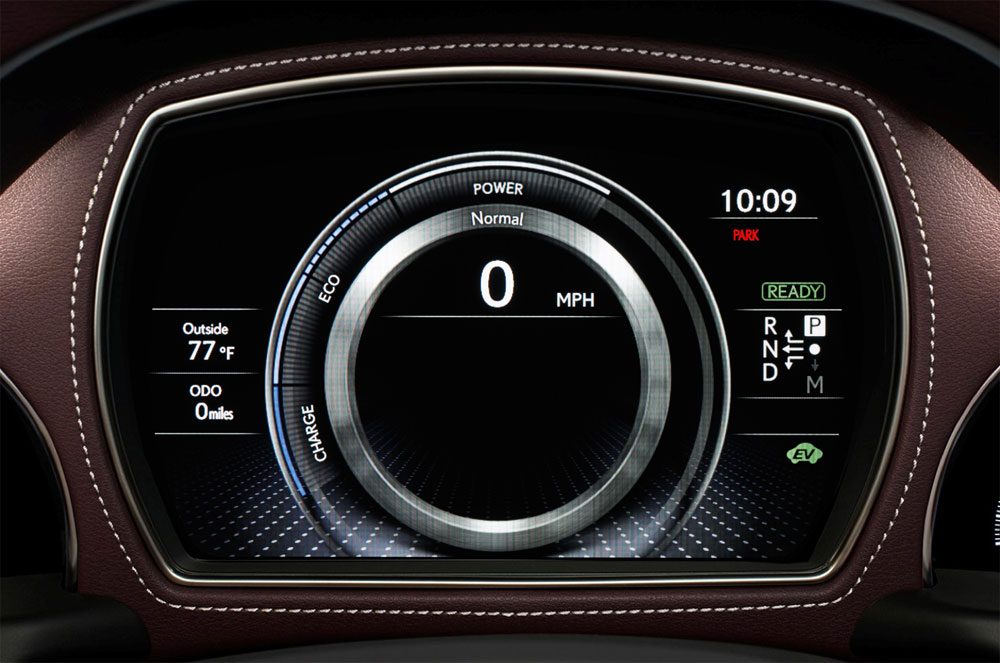
The F SPORT instrument panel looks directly lifted from the LFA supercar:
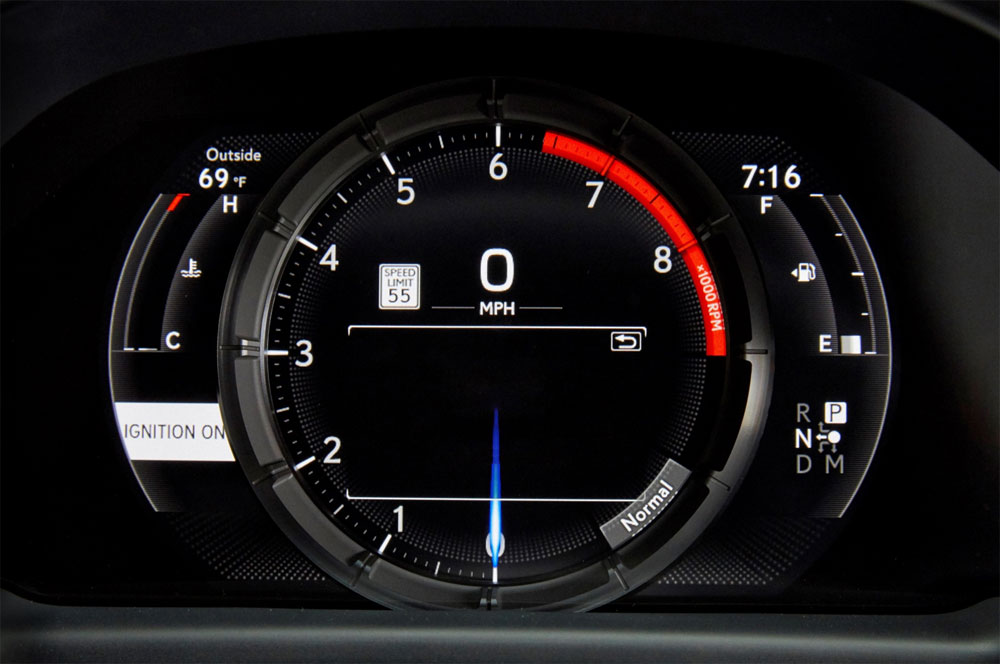
Drive Mode Select
Both the LS 500 & LS 500h are equipped with the Lexus Drive Mode Select, the system than enables the driver to customize the vehicle dynamics — here’s a graphical breakdown of the different modes:

Multimedia System
The flagship LS will introduce the next-generation Lexus multimedia system, which has been upgraded with new features and content — first off, the 12.3-inch high-resolution screen is standard:
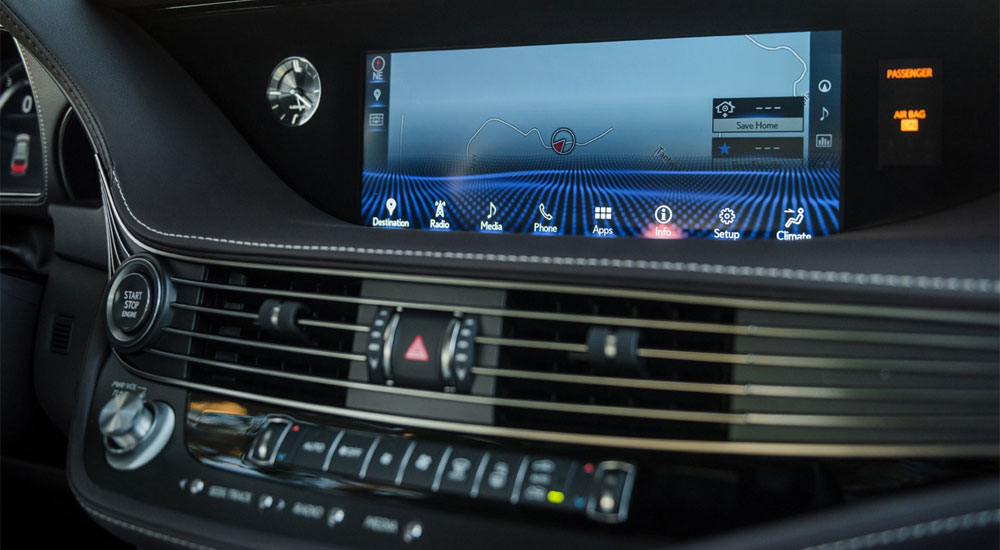
For the first time in a Lexus, a 4G LTE Data Communications Module (DCM) has been installed for data transmission. This allows for:
- Dynamic Map Updates – Real-time map updates downloaded from the cloud.
- Dynamic Routing – Navigation routes are now calculated using the most accurate and up-to-date routes and ETAs.
- One Box POI – Points of Interest can now be found through more casual voice recognition, there are approximately 14 million POIs on board and 20 million in the cloud.
Lexus Enform
Lexus Enform® will now be complimentary for 10 years, even over different owner changes:
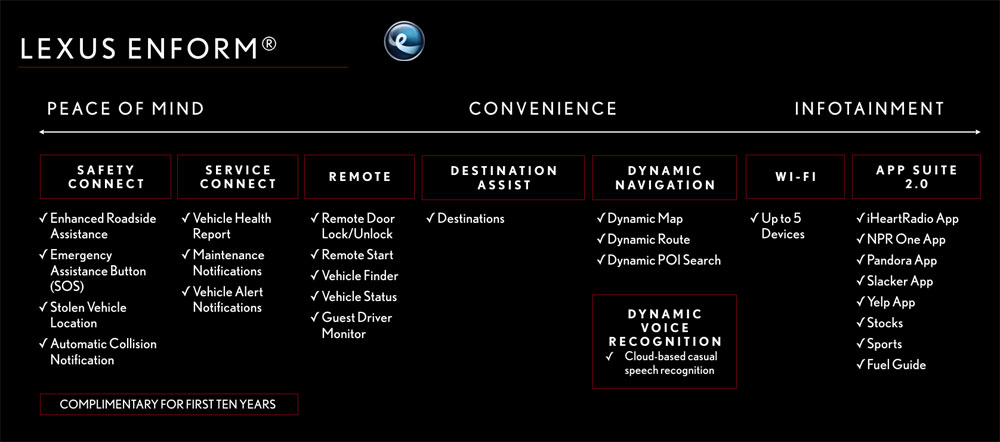
New with the LS is a wifi hotspot, which allows for five devices to use a shared data plan (more details forthcoming).
Heads-Up Display
A high-definition color Heads-Up Display (HUD) will be available on the new LS — measuring 600mm x 150mm (24-inch x 6-inch), it’s the largest in the premium large sedan class:
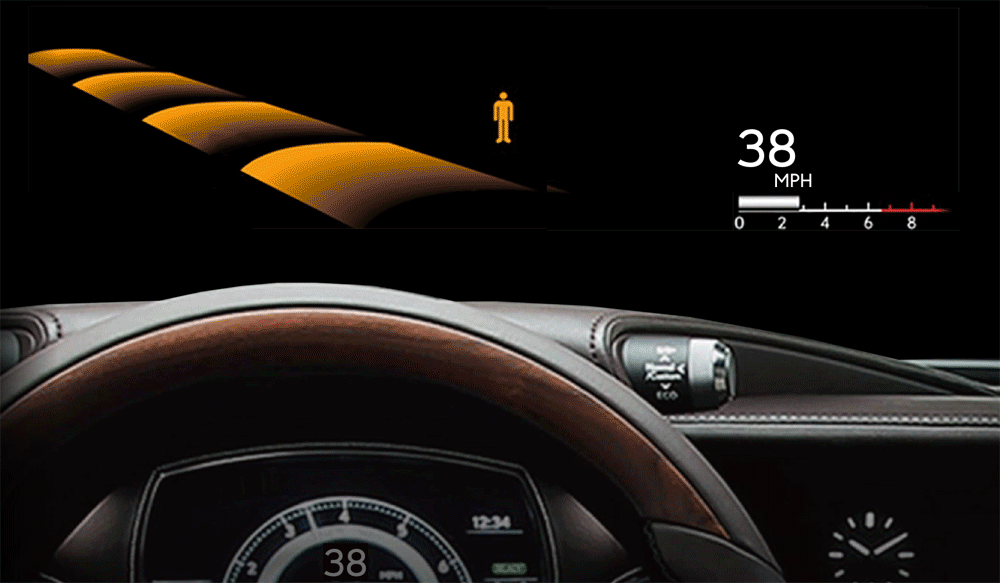
The HUD image appears is projected 3 meters (9-feet, 10-inches) ahead of the driver, reducing the need to change focus between the display and objects in front of the vehicle. The TFT (Thin Film Transistor) backlight optical lens has a maximum brightness 13,000 candela per square meter (cd/m2) — this is 2,000 cd/m more than the current RX HUD.
Climate Control
An infrared matrix sensor system is used to accurately determine the heating and cooling requirements within the cabin, allowing for finer control of the interior temperature:
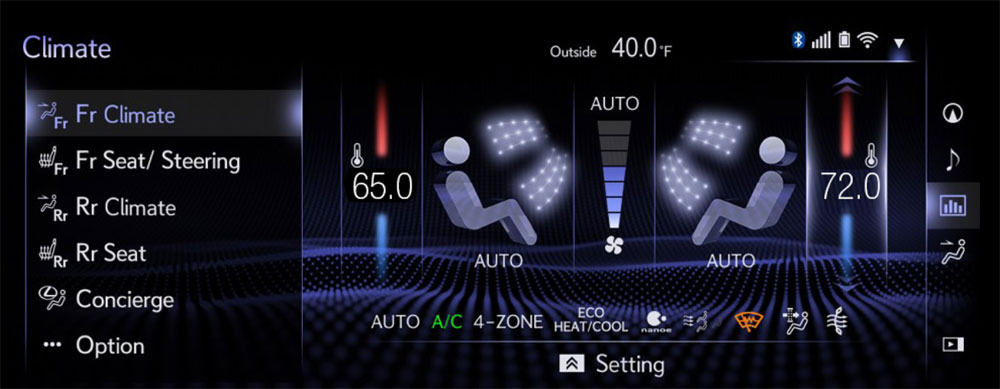
The number of temperature sensors has been increased to 16 from 6, providing a better mapping of the interior — this enables the air conditioning adjust for heat caused by uneven sunlight and chill from shadows.
Like other Lexus models, the LS will be available with Climate Concierge, a system that combines air conditioning, steering wheel heating, and seat fans & heaters to best serve every occupant’s desired temperature:
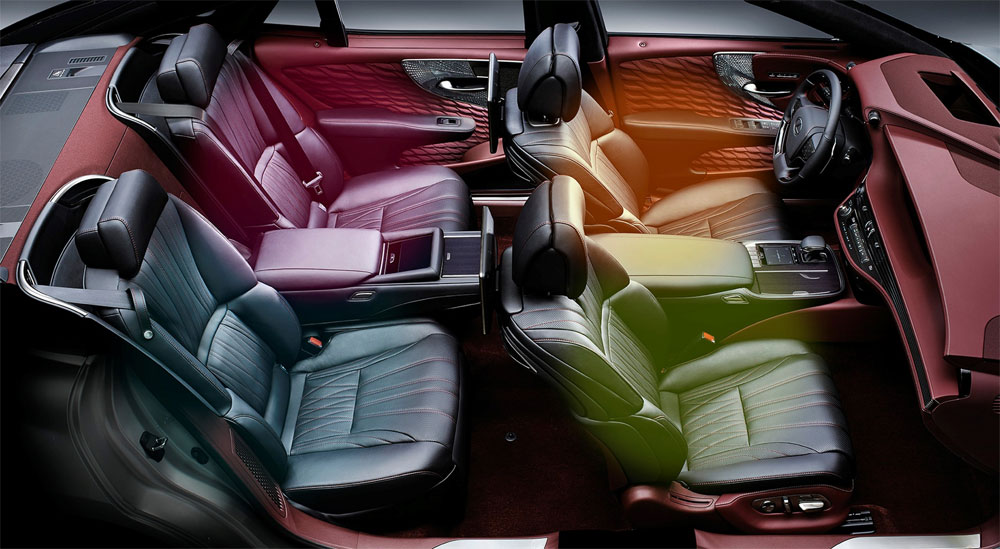
Remote Touch
The Lexus Remote Touch touchpad interface has been updated with a frameless design that’s 56% larger than the previous version, with a new sub function switch for access to additional menus and gesture controls familiar to smartphone users: Touch and drag, scrolling, pinch to zoom, and double-tap or press to click:
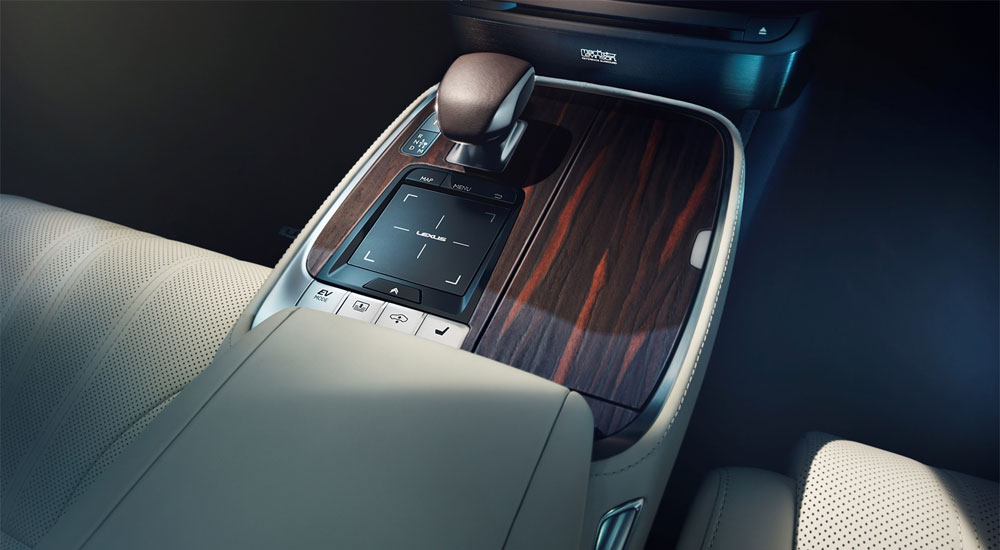
Sound Systems
A Pioneer 12-speaker audio system is standard, and breaks down as such — there are two 18cm woofers in the front doors, two 16cm woofers in the rear doors, seven 9cm speakers disperse through the interior, and a subwoofer in the rear deck:
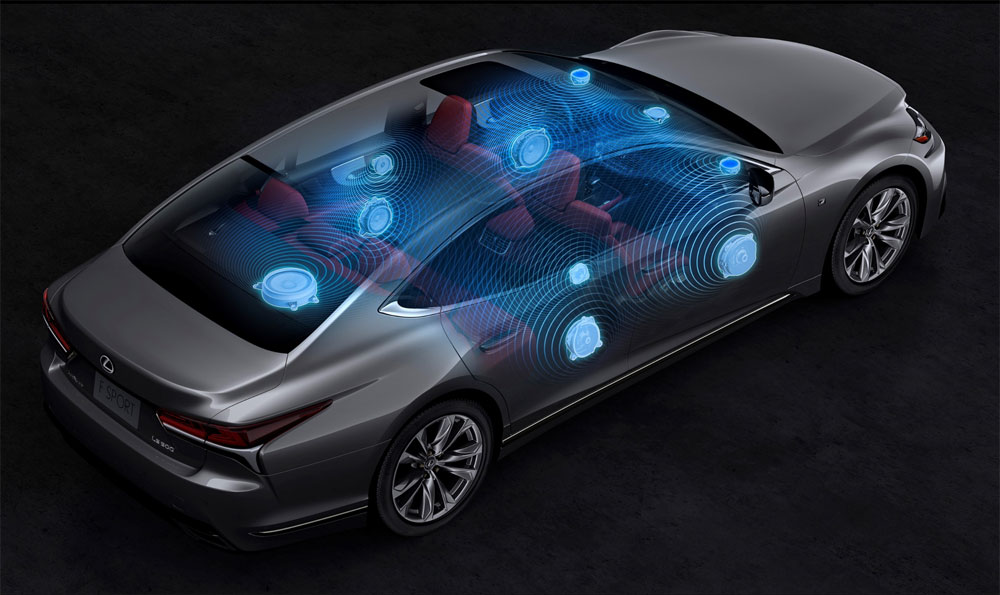
The optional Mark Levinson 3D QLI Reference Surround Sound System is a monster — it’s 7.1-channel surround sound though 23 speakers in 16 locations throughout the cabin (including dual 40mm in-ceiling speakers positioned above the seats), producing the equivalent of 2400 watts:
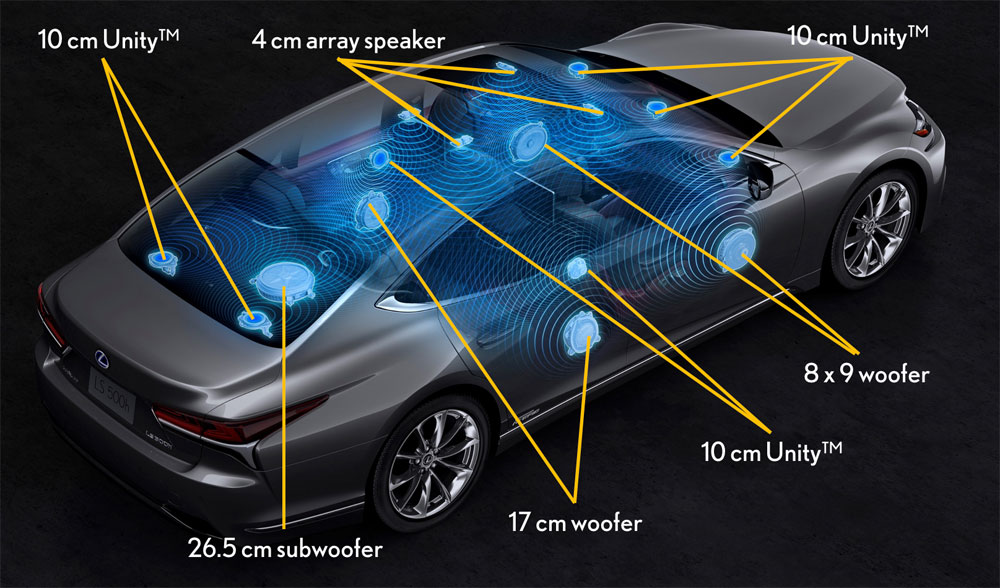
The complexity of this system is insane — the ML system in the fifth-generation LS is the world’s first automotive use of Quantum Logic Immersion, which digitally separates audio into individual streams – vocals, instruments, and spatial sound information. These streams are then remixed throughout the LS to match the original arrangement of musicians on stage or in the studio, placing each sound in the area you would expect to hear it in a live performance.
The ML system also uses Clari-Fi technology, which helps to correct compressed digital music from streaming services and satellite radio or other broadcasts.
Exterior Colors
The Lexus LS will be available in 10 colors, with some available only on non-F SPORT models and Ultra White being F SPORT only:
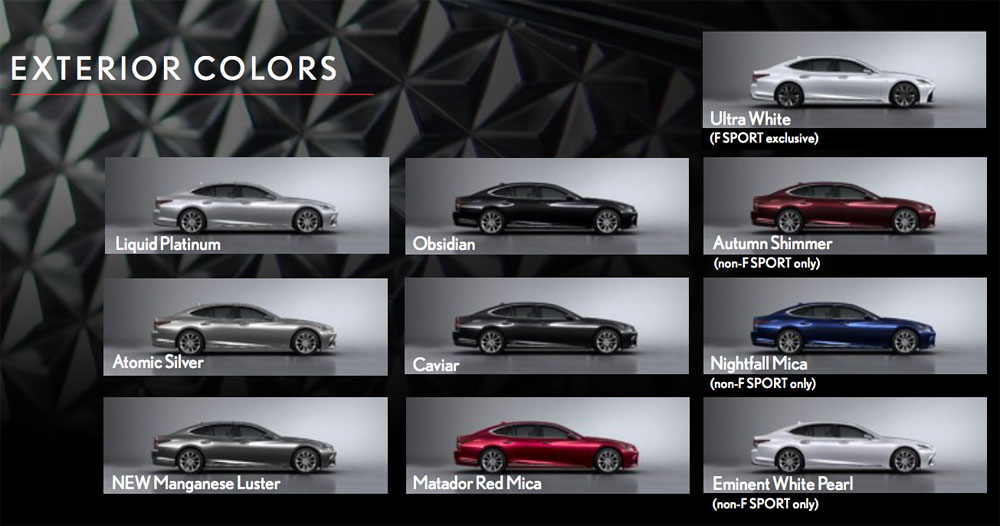
Interior Colors
The standard Lexus LS will have five interior colors to choose from:
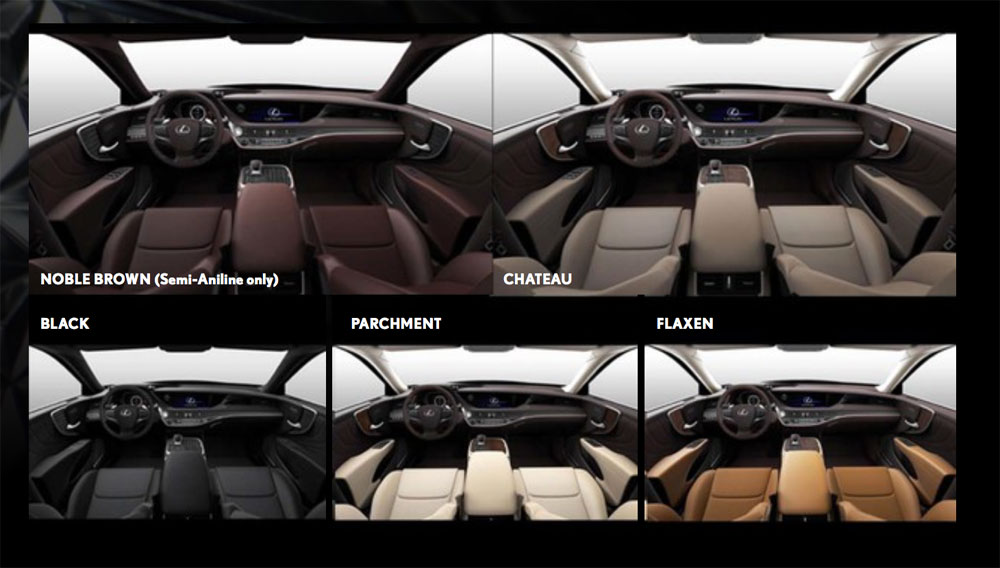
The Executive package will offer three interior colors, including an interior with black pleated door panels and laser-cut Kiriko glass:
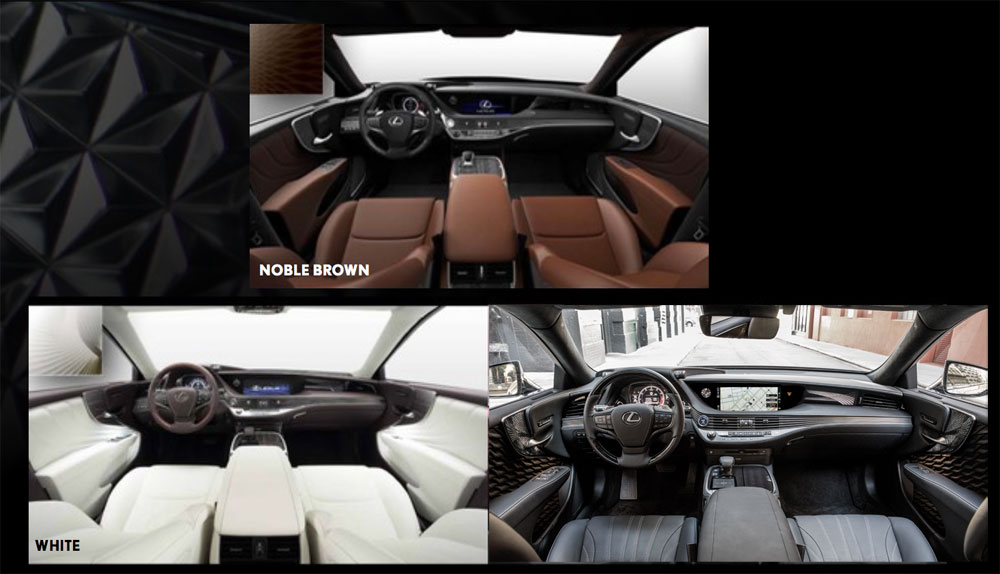
Finally, the LS F SPORT will have two interior options — Black and Circuit Red:

Safety
Lexus Safety System+ is standard on every LS, and there is an advanced suite of features in a new optional package called Lexus Safety System+ Advanced — here’s how the features break down:
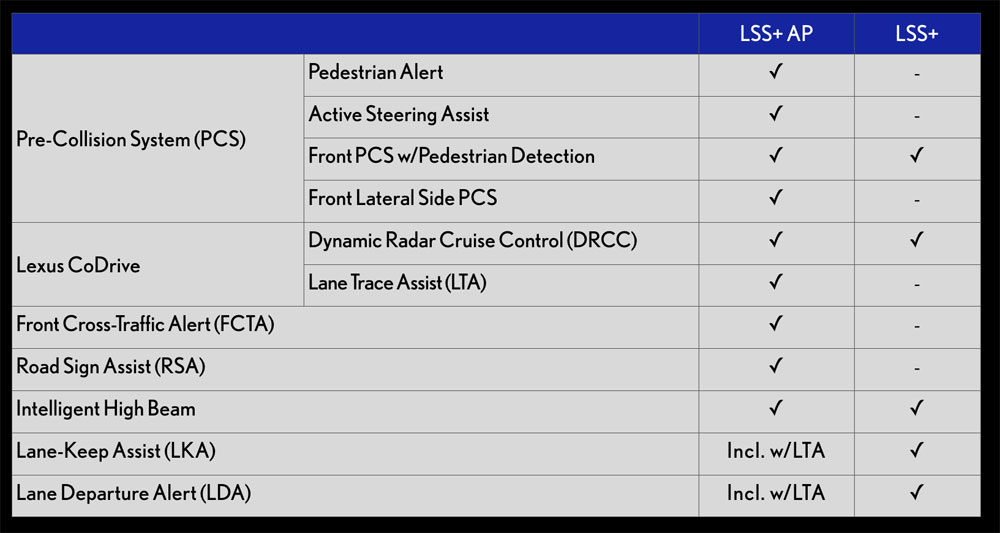
We’ve gone over the standard safety features in great detail before, so let’s focus on that first column — this upgraded system relies on an extended suite of cameras and sensors:
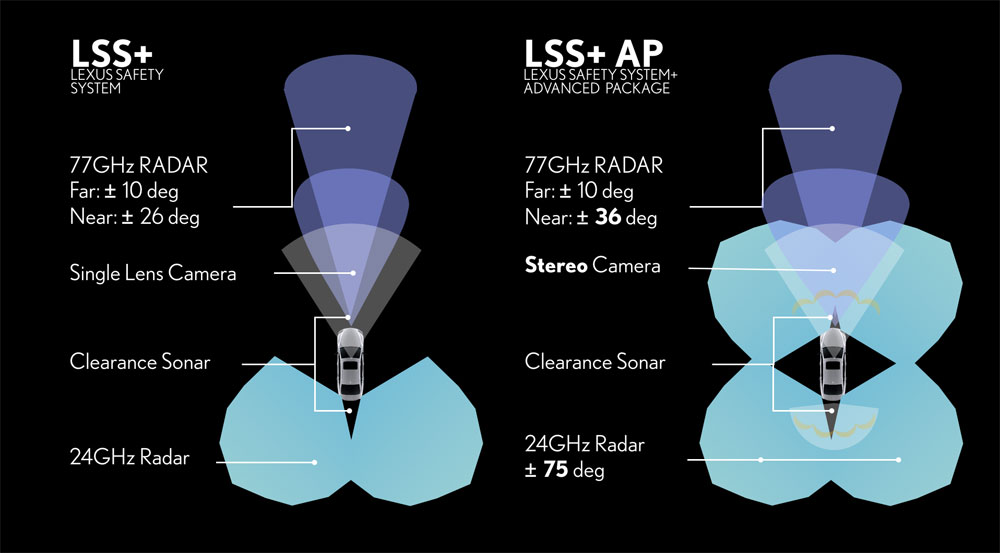
There are a number of world first technologies here, starting with the upgraded Pre-Collision System (PCS).
Pre-Collision System
Pre-Collision System (PCS) with Forward Collision Warning (FCW) and Automatic Emergency Braking (AEB) with Active Steer is a mouthful to say and to explain — lucky for us, there’s a video that covers the system in full:
Pedestrian Alert is a world-first technology that can display the direction a pedestrian is walking on the color heads-up display. Added to that is another world first, Active Steering Assist, which automatically controls steering and braking to avoid possible collisions while staying inside the current lane.
Front Cross Traffic Alert
Front Cross-Traffic Alert uses front side radar sensors to detect approaching vehicles (including bicycles) that may cross the vehicle’s path:
Panoramic View Monitor
Also equipped is a Panoramic View Monitor, which displays the LS’ surroundings on the multimedia display by using cameras installed the front, the left and right outer mirrors, and the rear:
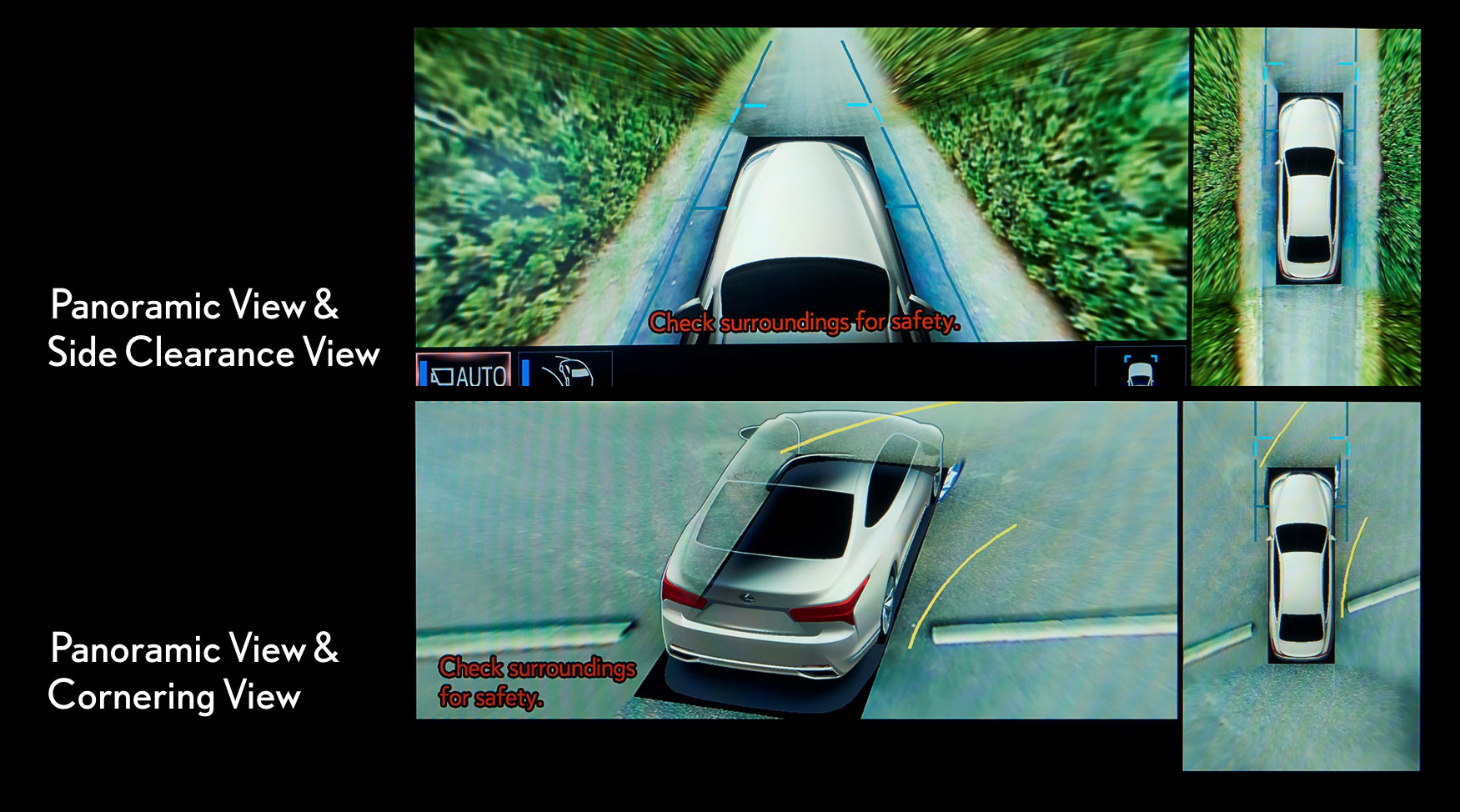
There are five different modes to choose from:
- Panoramic and Wide Front View provides a 180-degree view ahead of the vehicle using the front camera.
- Panoramic and Side Clearance View uses images from the front & side cameras to show the vehicle from above and behind.
- Panoramic and Cornering View displays an image from the rear of the vehicle to assist while cornering.
- See-Through View an rotating eye-level view around the car, as if the LS was fully transparent.
- Moving View displays a rotating bird’s eye image.
All-Speed Dynamic Radar Cruise Control (DRCC) with Full Speed Range
The first element of the new Lexus CoDrive system is an updated All-Speed Dynamic Radar Cruise Control (DRCC). Using a new millimeter wave radar sensor, stereo camera sensor, yaw rate sensor and a steering sensor, the system can lock onto preceding vehicles and maintain a suitable distance.
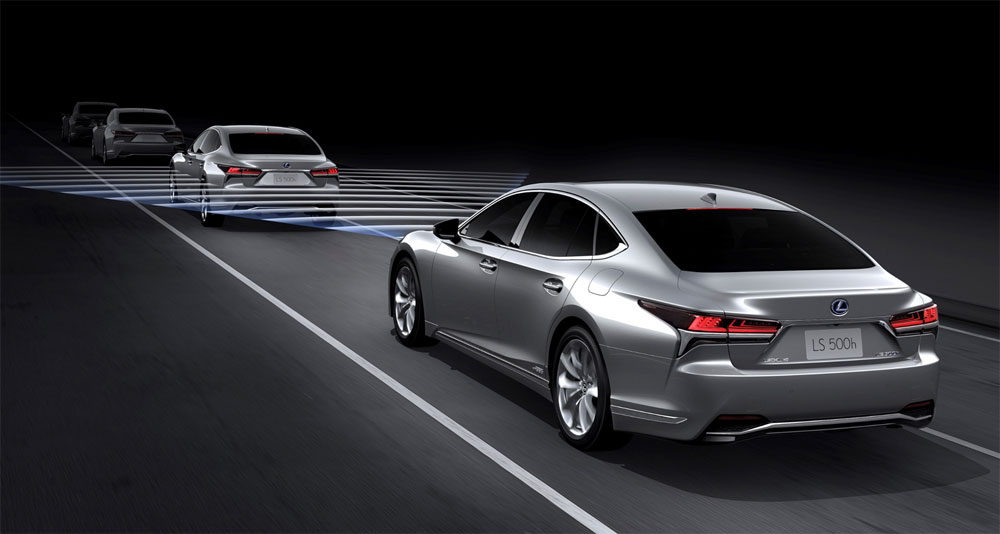
There is now enhanced accuracy for preceding vehicle recognition, path detection and cut-in vehicle detection, and acceleration and deceleration control have been revised to provide a smoother experience.
There’s also a new “blinker-linked” control — when following a vehicle travelling slower than the set speed, signaling a lane change will initiate acceleration to assist with passing. This kicks at speeds of 70 km/h (44 mph) or greater, and will not activate if there is a car in the passing lane.
Lane Trace Assist
The second element of Lexus CoDrive is Lane Trace Assist, an upgraded version of Lane Keep Assist. This system provides improved lane marker detection, along with the ability to use vehicles ahead as a guide — here’s a video that does a great job at explaining the system:
To ensure the driver is actually driving, a capacitative sensor uses the existing heater wires to detect the electrical current of hands on the steering wheel.
For how this improves on Lane Keep Assist, here’s a handy chart:
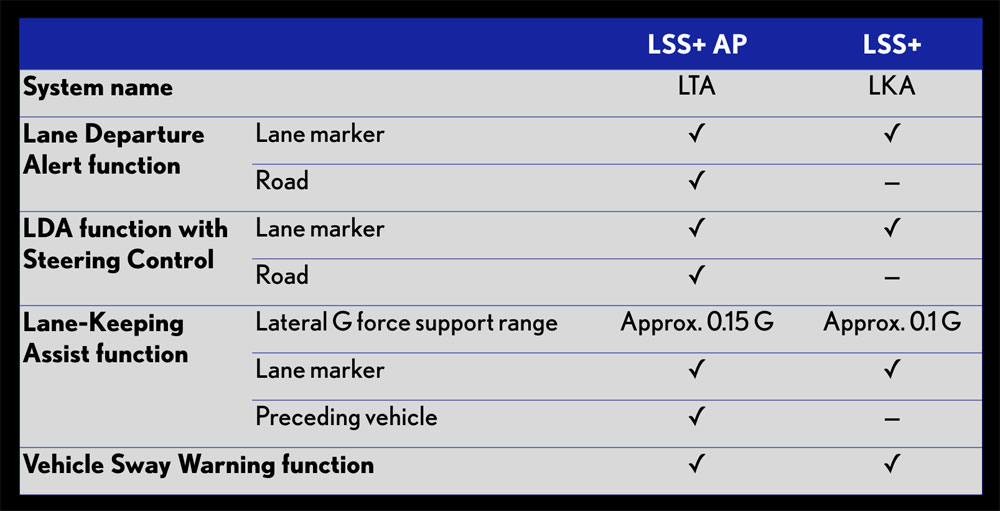
Road Sign Assist
Lexus Safety System +A can also detect road signs using the front camera, displaying prominently on the multi-information display and HUD:
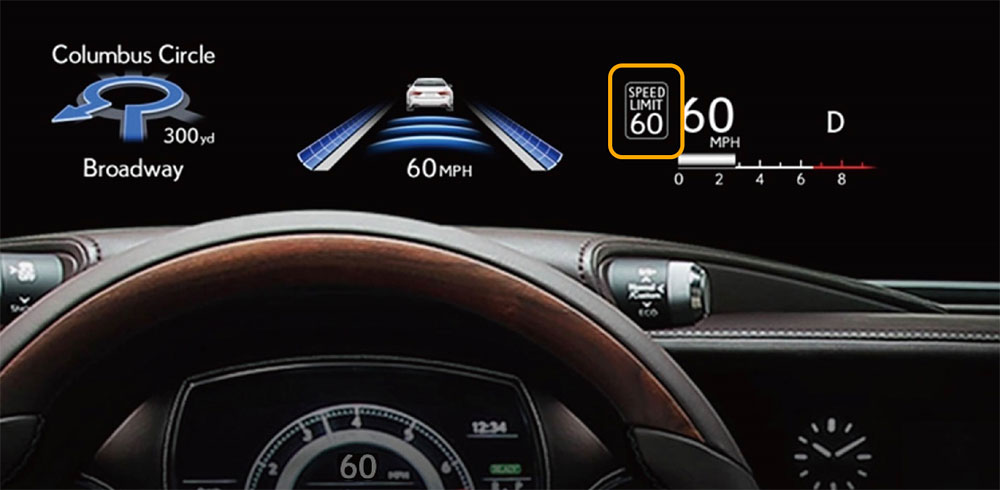
(Displayed North American speed limit signs are based on navigation data.)
Parking Support Brake
Parking Support Alert (PKSA) integrates various systems — Intuitive Parking Assist/Clearance Sonar, Rear Cross-Traffic Alert (RCTA) and the world-first feature Rear Camera Detection (RCD) — to help drivers navigate parking lots:
Pop-Up Hood
As an additional safety measure, the LS employs a pop-up hood in the event of a front impact with a pedestrian — the hood uses a series of pistons that rapidly elevates the hood in hopes of lessening personal injury:
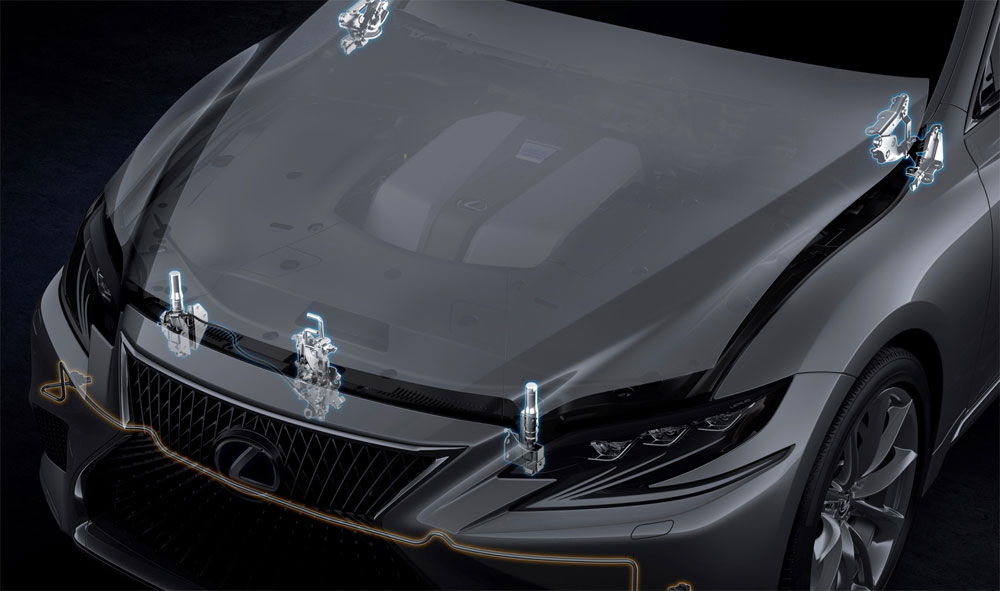
This concludes the technical overview of the Lexus LS 500 & LS 500h. Check back later this week for Kevin’s personal impressions! Our special thanks to Lexus USA for the invitation and hospitality during our trip to San Francisco.

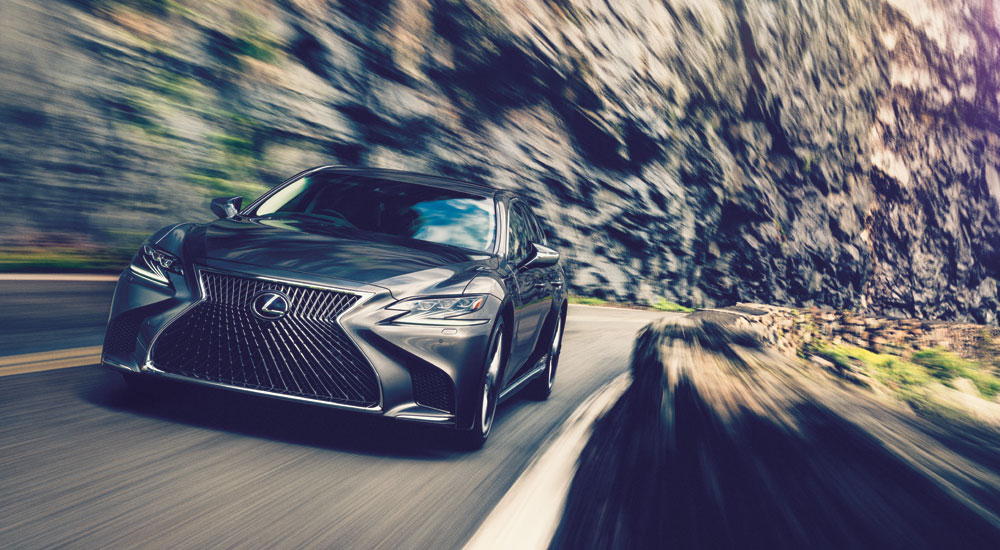
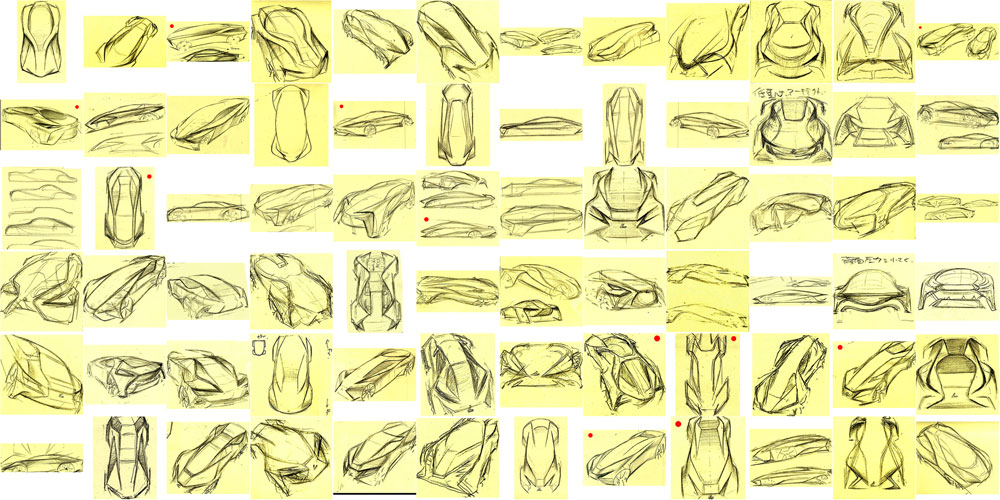
Comments